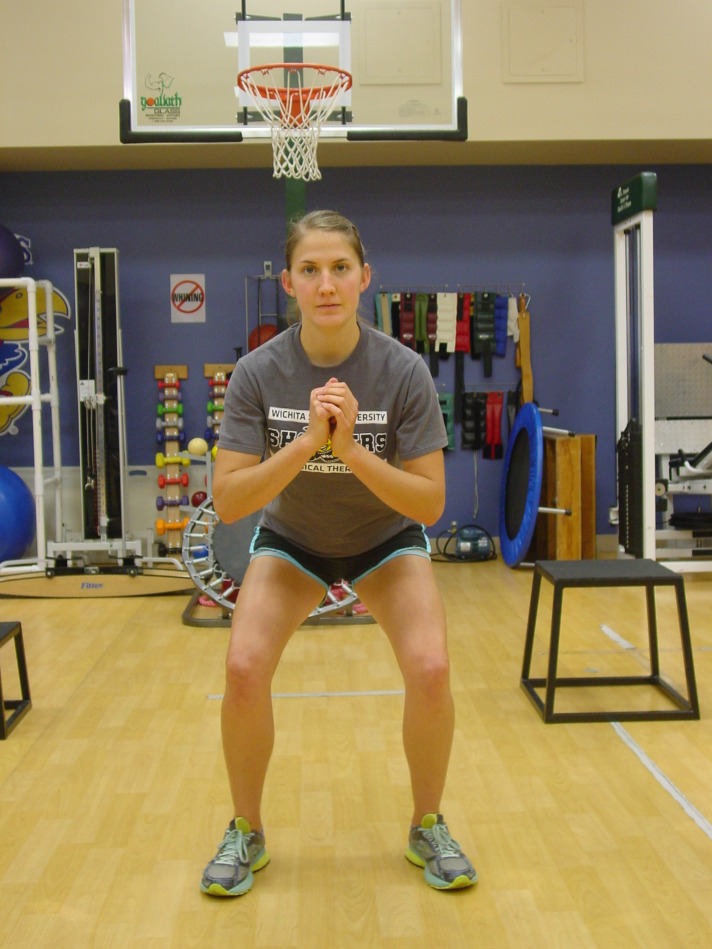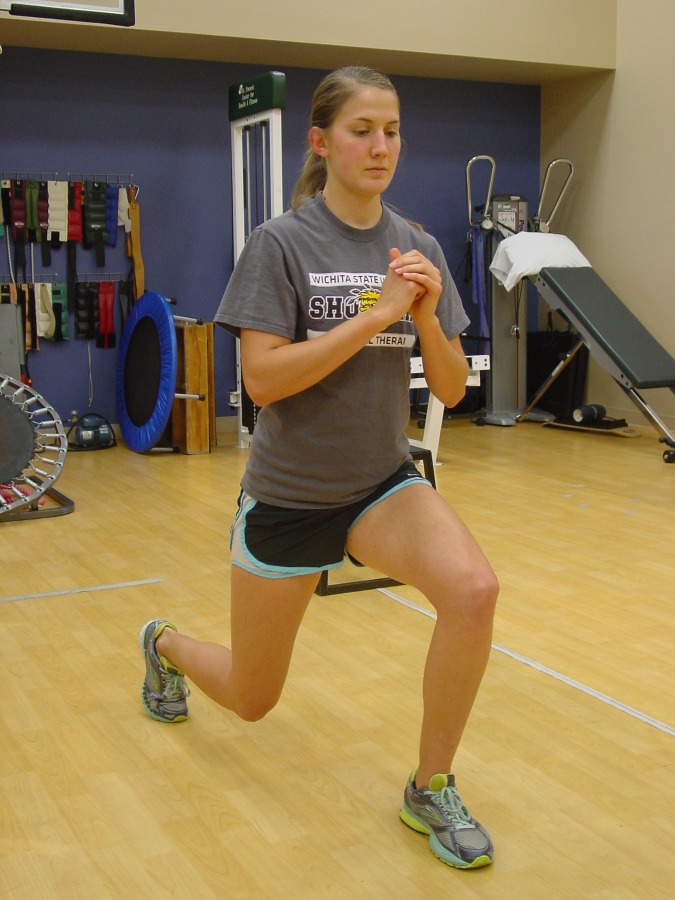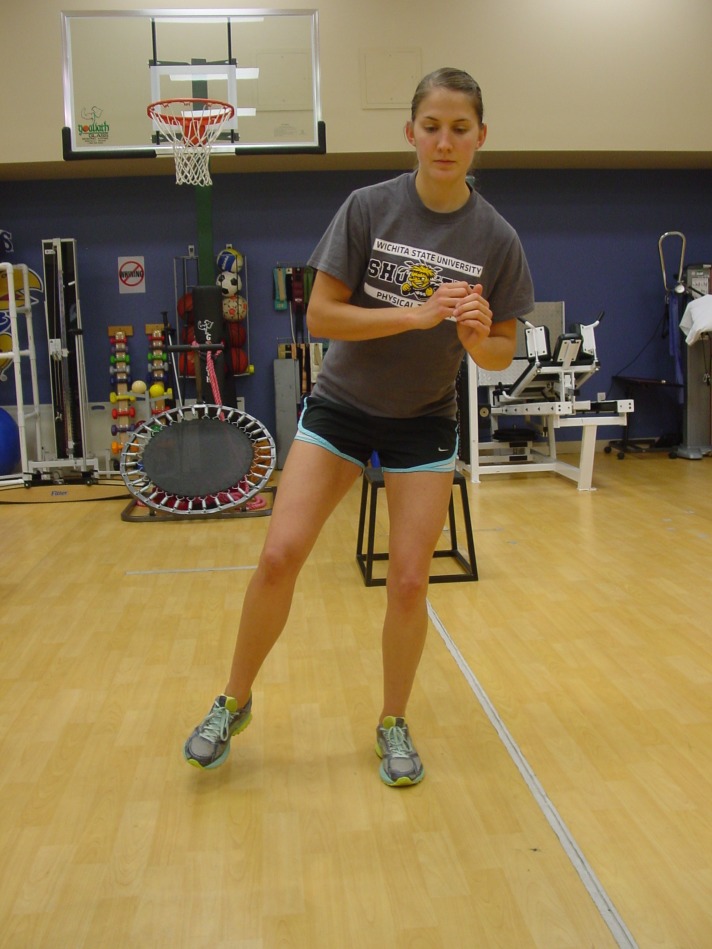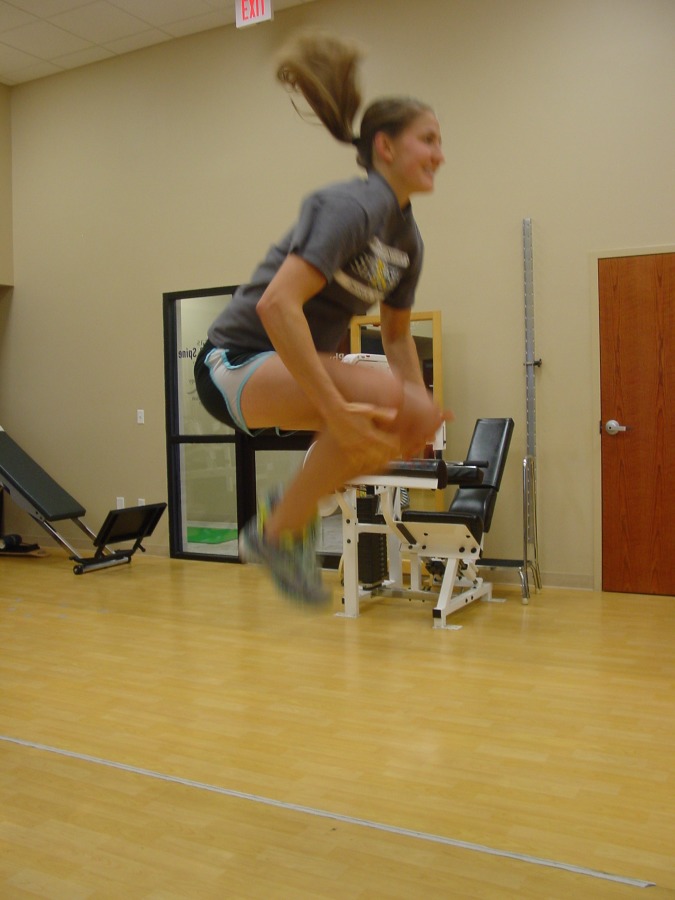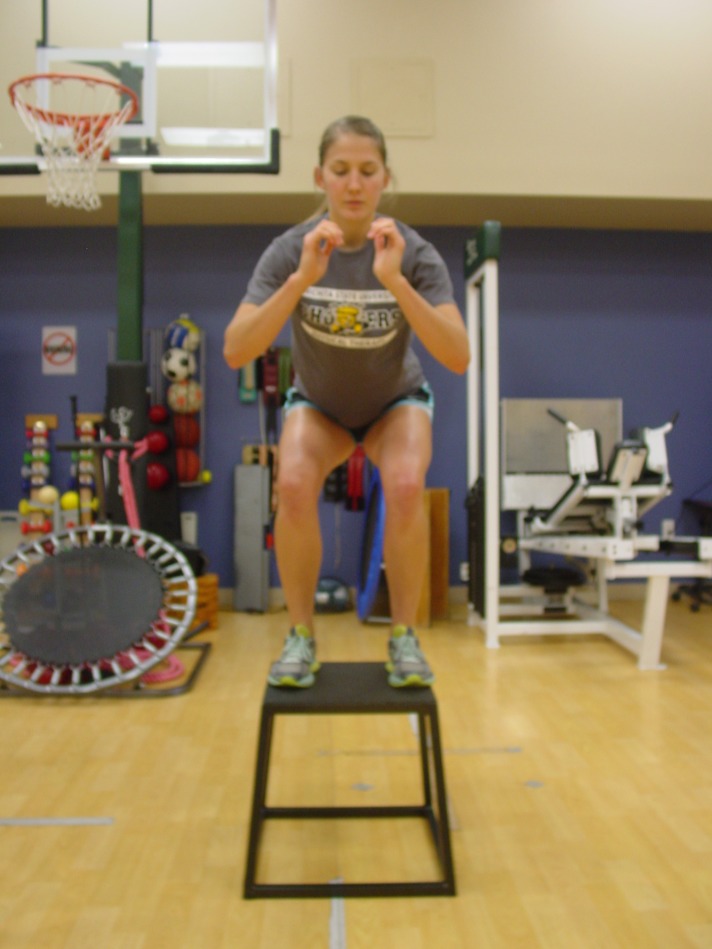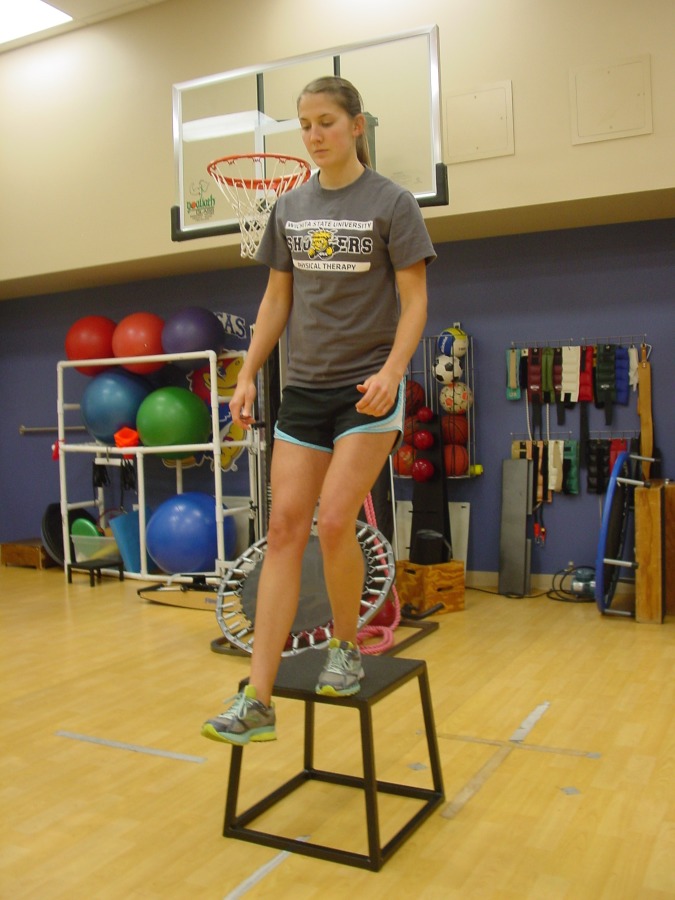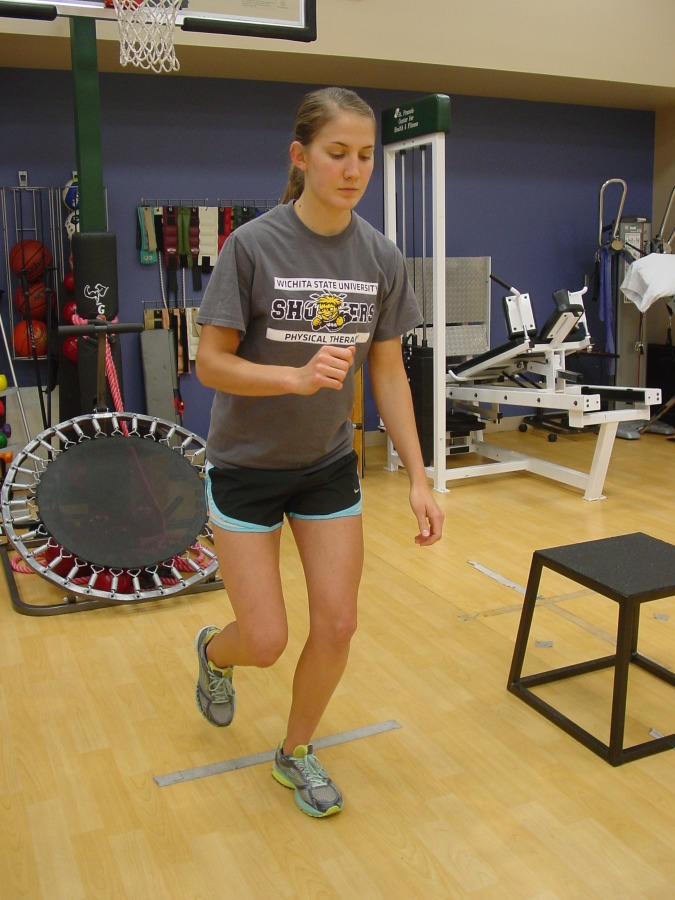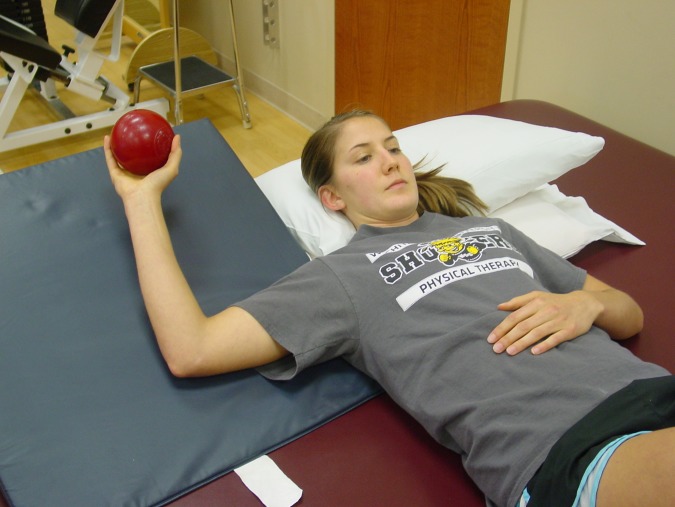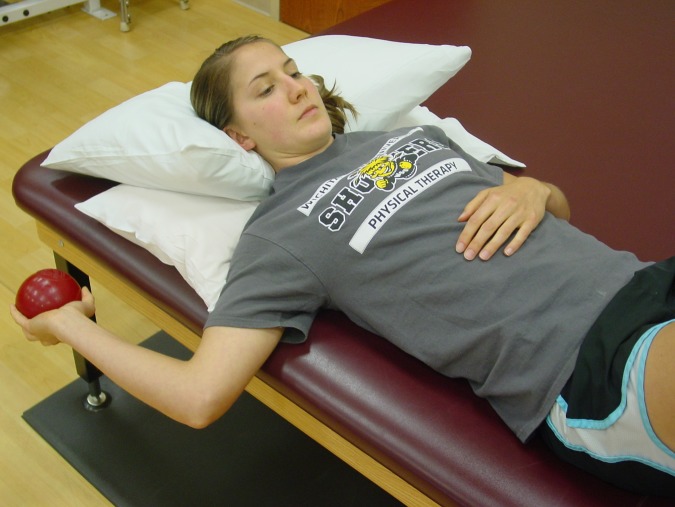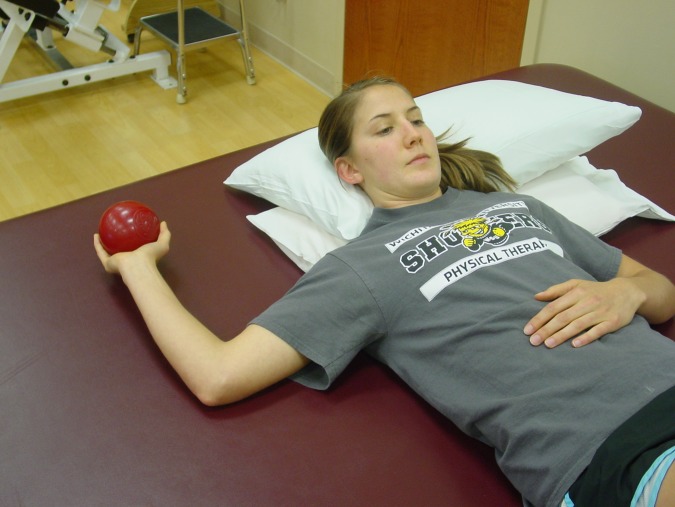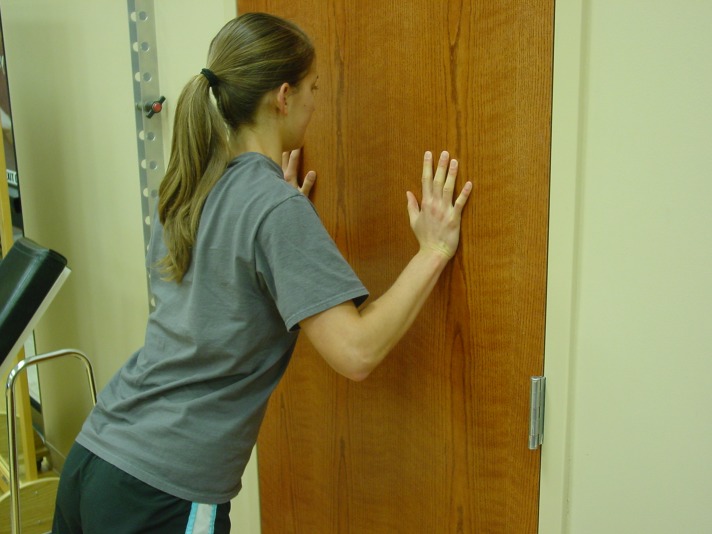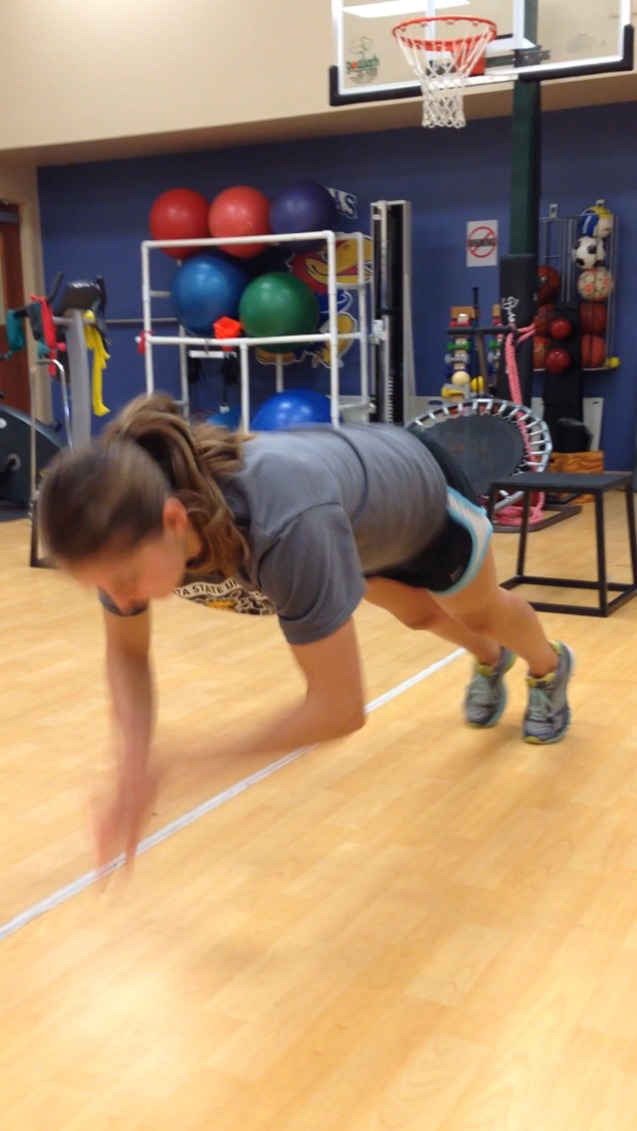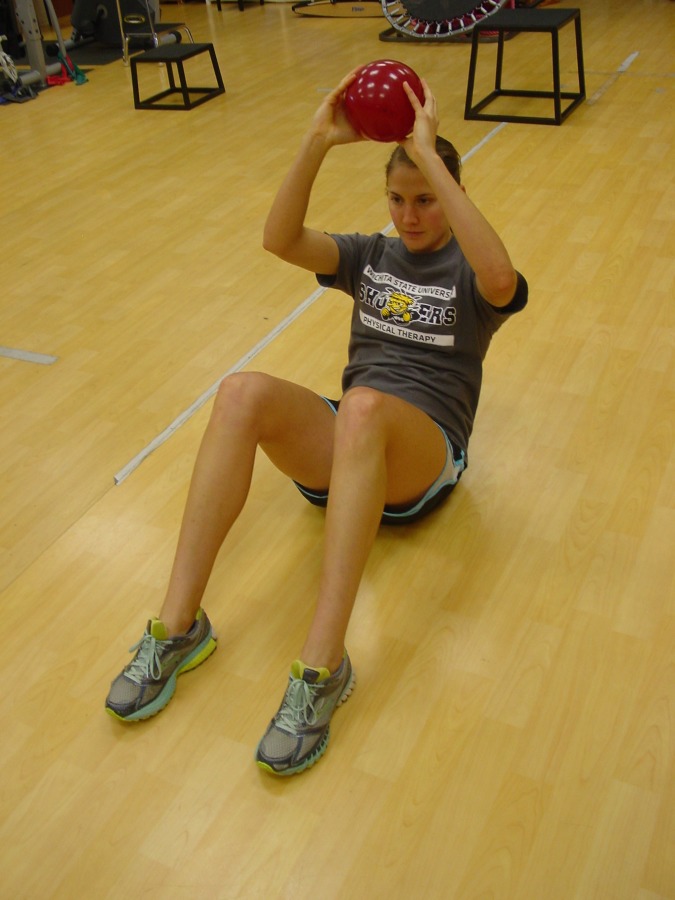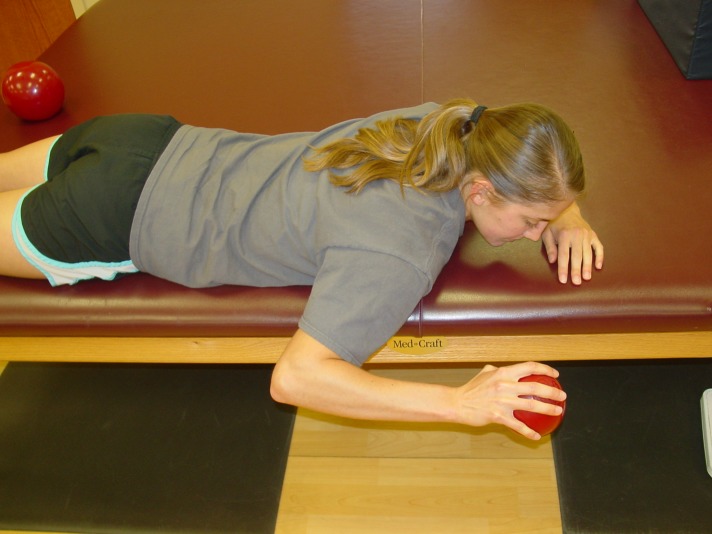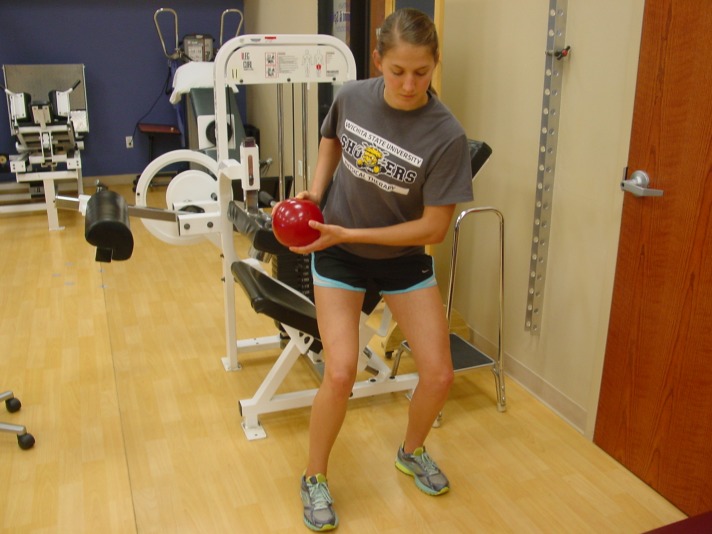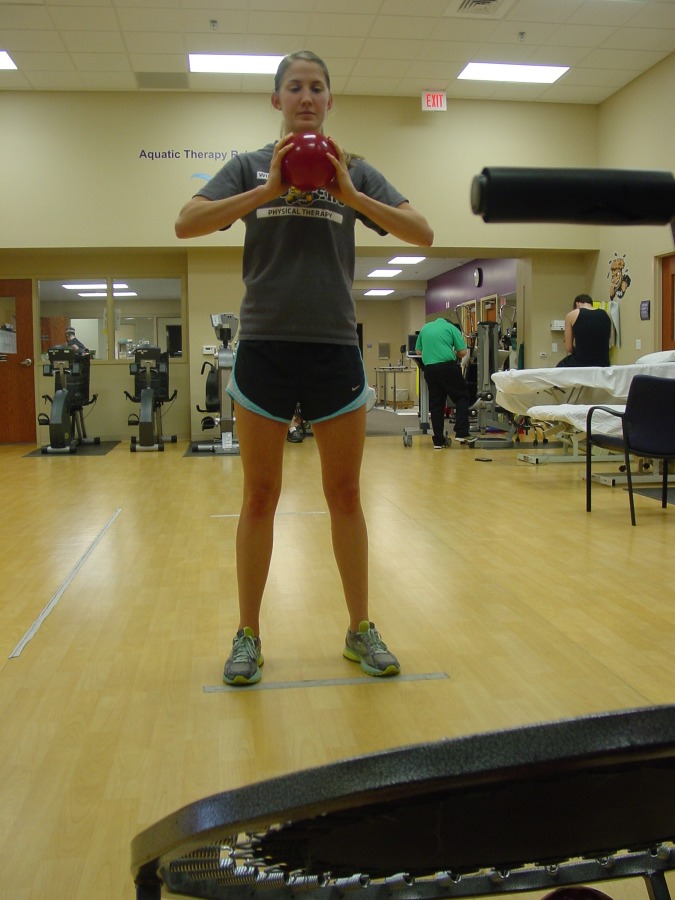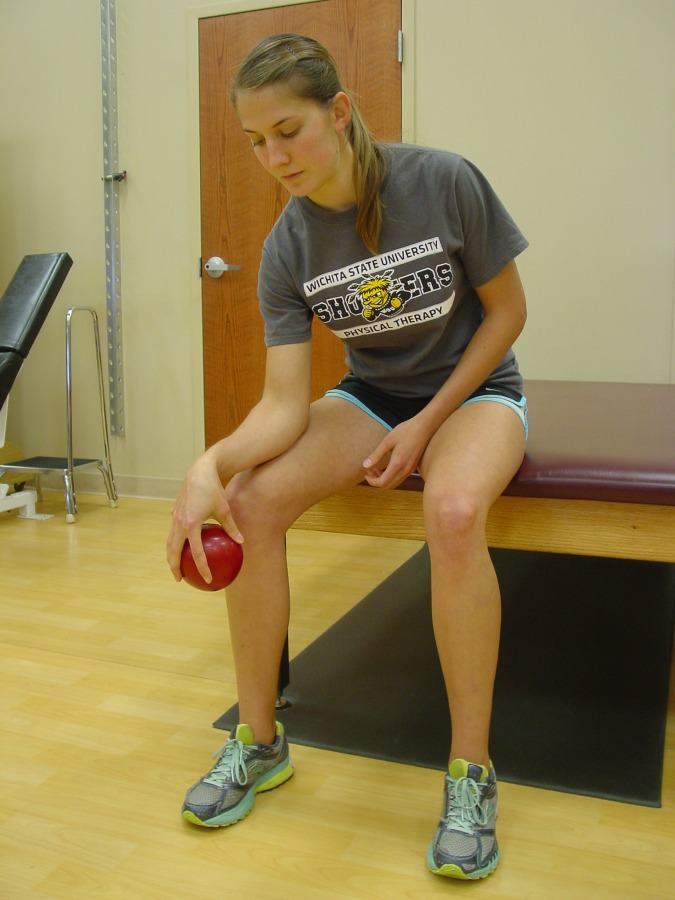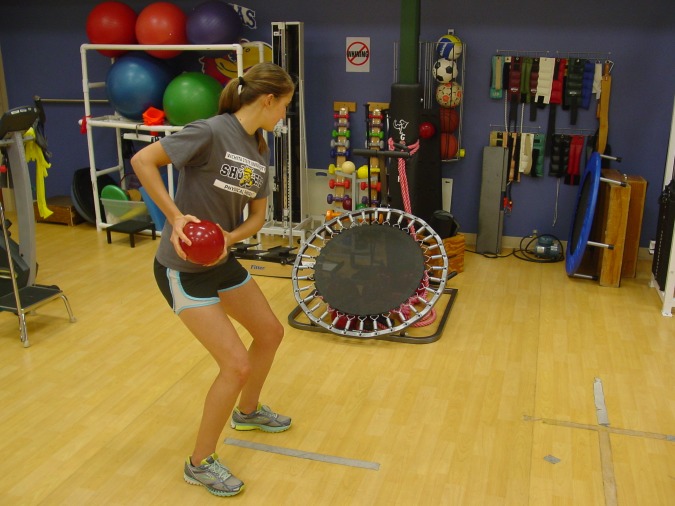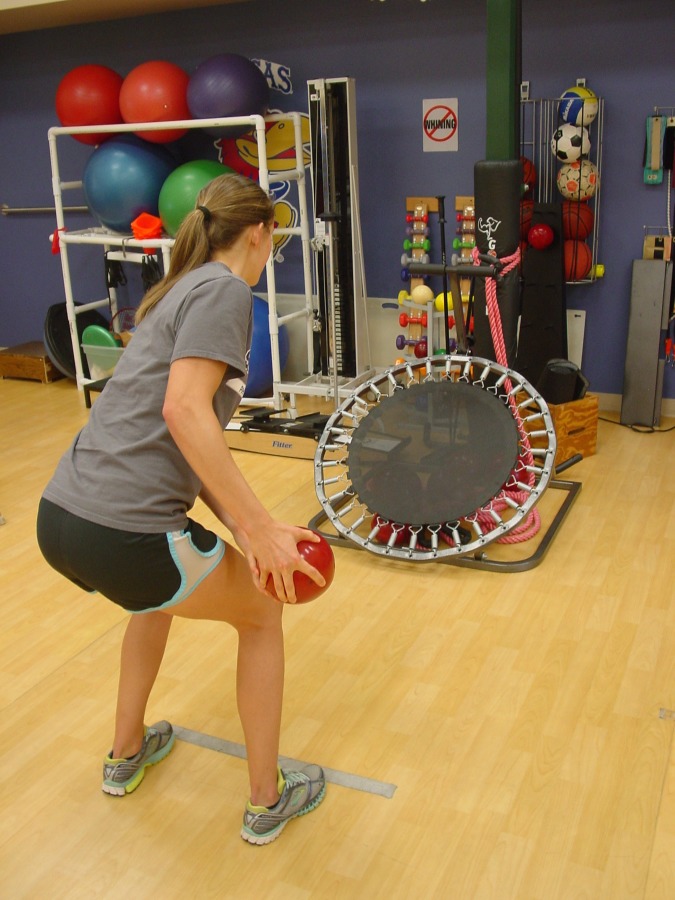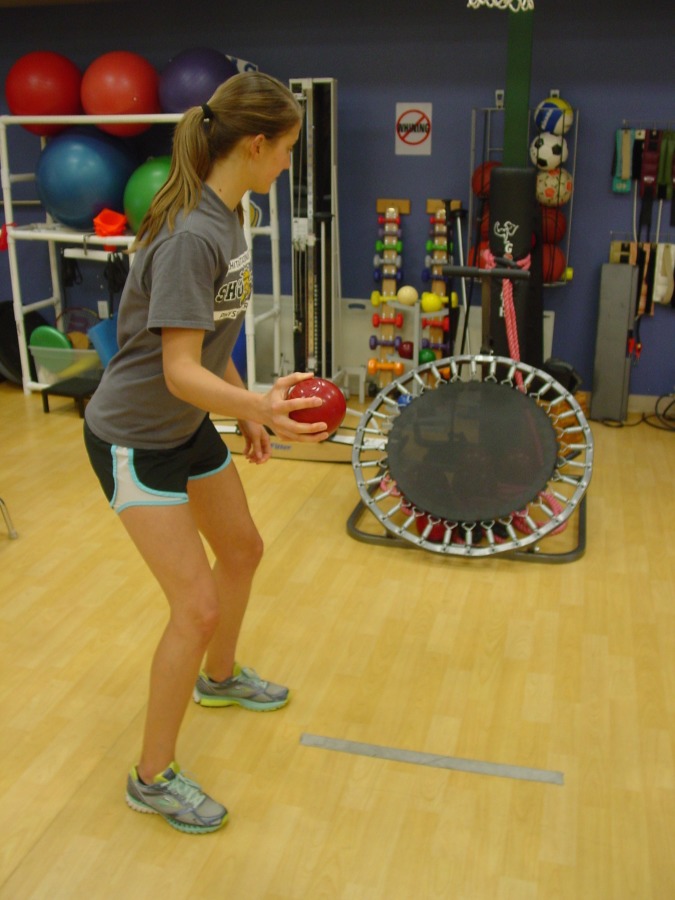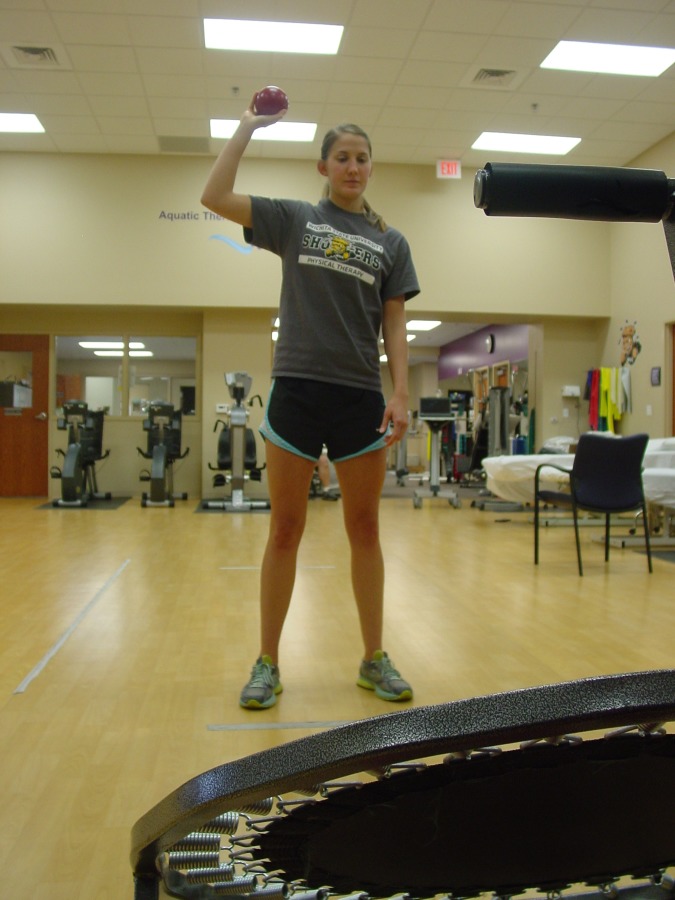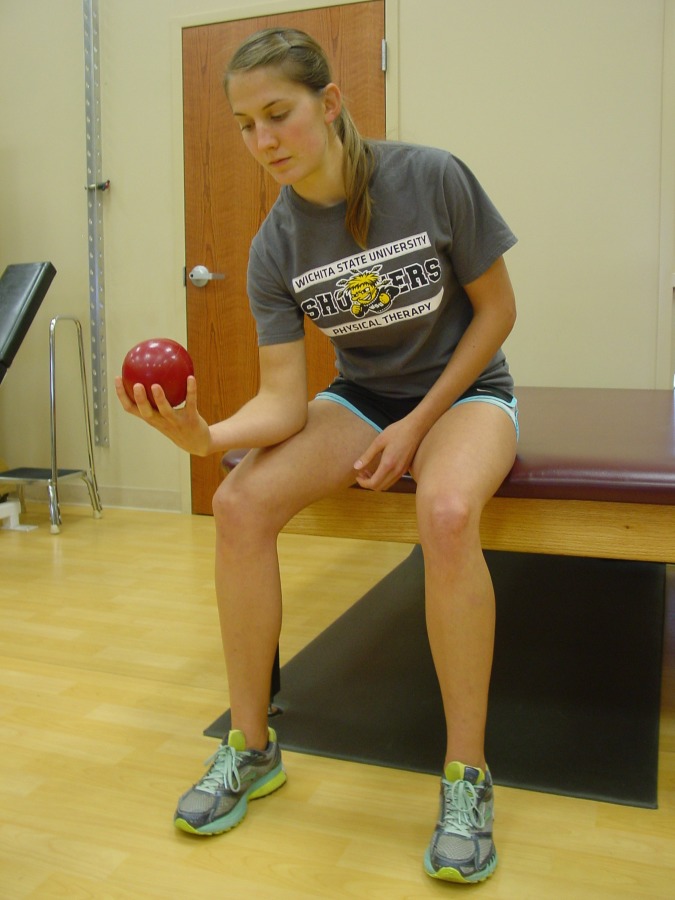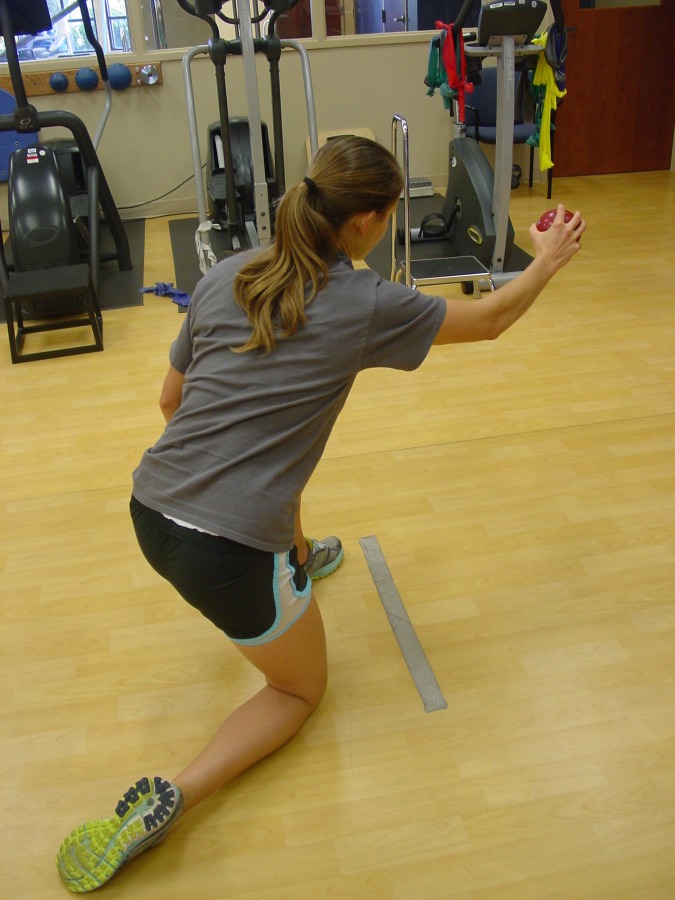Abstract
As knowledge regarding rehabilitation science continues to increase, exercise programs following musculoskeletal athletic injury continue to evolve. Rehabilitation programs have drastically changed, especially in the terminal phases of rehabilitation, which include performance enhancement, development of power, and a safe return to activity. Plyometric exercise has become an integral component of late phase rehabilitation as the patient nears return to activity. Among the numerous types of available exercises, plyometrics assist in the development of power, a foundation from which the athlete can refine the skills of their sport. Therefore, the purpose of this clinical commentary is to provide an overview of plyometrics including: definition, phases, the physiological, mechanical and neurophysiological basis of plyometrics, and to describe clinical guidelines and contraindications for implementing plyometric programs.
Keywords: Amortization, plyometric, rehabilitation, stretch shortening cycle
INTRODUCTION: AN OVERVIEW OF PLYOMETRICS
There are as many strength and conditioning programs as there are individual clinicians developing the programs. Rehabilitation programs have dramatically changed over the past several years. Regardless of the purpose of the program, whether it is used in the terminal phases of rehabilitation,1 for strength and conditioning, or for performance enhancement, plyometric exercise should play an integral part of the program. An important part of performance‐based rehabilitation programs is the development of power often addressed by using plyometric exercises. Sports physical therapists strive to prevent injuries, rehabilitate injuries in a timely manner in order to rapidly return athletes back to activity, improve the strength and conditioning of athletes, and facilitate the specificity of sports performance. Because of this there is an increasing demand to progress performance as quickly as possible. Plyometrics may be incorporated as an integral component of an exercise program that can produce all the aforementioned outcomes. As tremendous forces are imposed on the extremities during sports and athletics, there is a huge demand to develop power during the performance phase of rehabilitation. The concepts of specificity of rehabilitation and the SAID (Specific Adaptation to Imposed Demands) principle imply the need for periodization programs to be incorporated in the terminal phases of rehabilitation, as well as conditioning and performance programs. Of the numerous types of available exercises, plyometrics assist in the development power, a foundation from which the athlete can refine the skills of their sport. Therefore, the purpose of this clinical commentary is to provide an overview of plyometrics including: definition, phases, the physiological mechanical and neurophysiological basis of plyometrics, and to describe clinical guidelines and contraindications for implementing plyometric programs.
PHASES OF PLYOMETRICS
Why should plyometric exercises even be used for rehabilitation or performance enhancement in sports? Both lower extremity (LE) and upper extremity (UE) sports use the plyometric concept as part of functional movement patterns and skill when performing the sport. Plyometric training utilizes the stretch‐shortening cycle (SSC) by using a lengthening movement (eccentric) which is quickly followed by a shortening movement (concentric).2‐16
Eccentric Pre‐Stretch
The eccentric pre‐stretch phase has also been described as the readiness, pre‐loading, pre‐setting, preparatory, faciliatory, readiness, potentiation, counter‐force, or counter‐movement phase. The eccentric pre‐stretch phase of a plyometric activity stretches the muscle spindle of the muscle‐tendon unit and the non‐contractile tissue within the muscle (series elastic components [SEC] and parallel elastic components [PEC]). This stimulation of the components of the muscle is often referred to as the neurophysiological‐biomechanical response. Several researchers17‐24 have demonstrated this eccentric pre‐stretch will enhance the resultant concentric muscle contraction. The pre‐stretch phase is predicated on three stretch variables: magnitude of the stretch, rate of the stretch, and duration of the stretch.17‐26 Manipulating any of these variables will have a significant effect on the amount of energy stored during the eccentric pre‐stretch motion.
Amoritization Phase (Time to Rebound)
The term amortization has been developed to describe the time from the cessation of the eccentric pre‐stretch to the onset of the concentric muscle action. Authors of this manuscript prefer to use the term “time to rebound”. This phase is also frequently referred to as the electro‐mechanical delay phase of plyometrics. The amortization phase is the time delay between overcoming the negative work of the eccentric pre‐stretch to generating the force production and accelerating the muscle contraction and the elastic recoil in the direction of the plyometric movement pattern.15‐21 This phase is the key to the performance of plyometrics, because the shorter the amortization phase the more effective and powerful is the plyometric movement because the stored energy is used efficiently in the transition. If the amortization phase is delayed, the stored energy is wasted as heat, the stretch reflex is not activated and the resultant positive work of the concentric contraction is not as effective.27 One of the primary goals of plyometric training is to decrease the time to rebound phase.
Concentric Shortening Phase
The concentric phase can also be referred to as the resultant power production performance phase. This phase has also been described as the facilitated or enhancement phase of plyometrics.27 These terms actually describe what happens during the plyometric activity. This final phase of the plyometric movement results from many interactions including the biomechanical response that utilizes the elastic properties of the pre‐stretched muscles. 28‐30
The blending of these three phases to perform a plyometric movement is used to enhance the muscle's power performance.17,18,30 Designing the periodization programs31,32 and execution of the actual plyometric drills described later in this article is what makes these exercises so effective in performance enhancement.
EXAMPLES OF PLYOMETRICS IN ATHLETICS
This rapid deceleration‐acceleration produces an explosive reaction that increases both speed and power of the limb during athletic activities.33 This explosive reaction facilitates the production of maximal force in the shortest amount of time.34,35 Plyometric training is often considered the missing link between strength and return to performance.36 An example of the SSC is illustrated during the overhead pitching motion. When the pitcher goes into the late cocking position, the muscle spindle and the PEC and SEC of the shoulder internal rotator muscles are pre‐stretched, in order to enhance the acceleration phase of the pitching motion. The necessity of plyometrics for the shoulder complex can be illustrated in the context of the incredible demands placed on the shoulder with different sporting activities. For example, overhead throwing produces angular velocities that exceed 5000‐7000 degrees per second,37 which makes the SSC necessary to help generate the forces required. With a short amortization phase, the time from the cessation of the eccentric pre stretch to the onset of the concentric muscle action, the SSC permits stretching (eccentric lengthening) to contribute to the maximal explosive shortening (concentric contraction).
The follow through phase of the throwing motion actually generates the highest electromyographic (EMG) activity of the posterior shoulder complex as well as the core stabilizers and the scapulo‐thoracic muscles.38 Volleyball players and tennis players use an abbreviated cocking motion to strike the ball, but still use the SSC during their functional tasks. Baseball or softball pitching motions are movements with a controlled plyometric movement, whereas the volleyball and tennis motions are usually reactive movement patterns, which occur more quickly. The other common overhead activity is swimming which actually involves more repetitions in the overhead position than most other sports; however, swimming involves minimal ballistic plyometric movements.
There are many examples of plyometric activities in the lower extremities, such as running, jumping and kicking. The angular velocities of the knee have been recorded at around 1,000 degrees/second.39,40 With each foot contact, there is an eccentric stretch followed by the concentric shortening contraction. Jumping, cutting and pivoting activities occur in almost all sports and each has plyometric demands, thus the concept of power development is the key for many activities of daily living, work related activities, recreational, and competitive sports.
Realizing the fast angular velocities and tremendous forces required in various activities of daily living and sporting activities, illustrates the need for plyometric training in preparing the patient or athlete for return back to their activities. Rehabilitation and conditioning programs are designed to return patients and athletes back to their respective activities as safely and quickly as possible based on functional specific activities. Plyometric exercises should play a critical role in this important role to develop power for performance.
DEFINITION
Plyometrics have been used for many decades in the Russian and eastern European training of track and field athletes.2,3,5‐7,37,41‐44 Verkhoshanski,45‐46 a well‐known track and field coach in Russia, began the concept that he referred to as shock training or jump training. However, former Purdue University women's track coach Fred Wilt first coined the actual term plyometrics in 1975. The word plyometrics is actually a derivation from the Greek words plythein or plyo, which means to increase and metric, which means to measure. Consequently, the purpose of plyometrics may be thought of as “to increase the measurement.” Typically the measurement is sports performance outcomes demonstrated in testing or competition such as throwing, serving velocity, jump height or sprint speed. 47‐49
SCIENTIFIC FOUNDATION FOR THE APPLICATION OF PLYOMETRICS
Physiologic Basis
The contractile component of the actin and myosin cross bridges with the sarcomere plays an important role in motor control and force development during plyometrics. The plyometric movement uses the pre‐stretch of the muscle‐tendon unit physiological length‐tension curve in order to enhance the ability of the muscle fibers to generate more tension and resultant force production. 15,27 Biomechanically “priming” the muscle is supported by the work of Elftman.50 The Elftman proposal simply states that the force production of muscle is arranged in a predictable hierarchy. This orderly format is that eccentric muscle contractions create the most force, followed by isometric contractions and then concentric contractions. Concentric muscle contractions therefore, are actually the weakest of the three modes of muscle actions. However, plyometrics create the greatest forces during the concentric power production phase. It is for this reason that the eccentric pre‐stretch and the short amortization phases are so critical for the optimum power development in a muscle.
However, whenever an eccentric muscle action occurs, there is concern for the development of delayed onset muscle soreness (DOMS).14,15,57 DOMS will always occur in the skeletal muscles following an unaccustomed eccentric exercise. When a maximal eccentric muscle action occurs, it generates 10‐40 percent more force than concentric contractions. The reason it generates more force is because during the eccentric muscle action the SEC and PEC are being stretched which generates more force (than during concentric), which in turn causes microtrauma to the connective tissue. The microtrauma to the SEC and PEC releases hydroxypropline which creates a noxious stimulus to the muscles and that creates the participants perception of the DOMS response.52‐57 Therefore, it is important to inform the athlete when starting a plyometric program they will experience a DOMS response.15 It is critical to explain to the athlete that DOMS is a self‐limiting conditioning and usually resolves in approximately 7‐10 days. If the participant is a highly trained athlete, due to a repeated bout effect, they will not usually experience a DOMS response.58 The education of athletes about DOMS is important when implementing plyometrics into the terminal phases of a rehabilitation program or into a performance enhancement program.
Rapid voluntary contractions of skeletal musculature are achieved via selective recruitment of motor units. It is generally accepted that recruitment of muscle fibers follows an orderly pattern or sequence termed the size principle. Slow twitch (ST) fibers are typically recruited at sub‐maximal intensity efforts, and then as the intensity increases, the fast twitch (FT) IIa fibers are recruited at approximately 30 percent up to about 80 percent of maximal intensity. At approximately 70‐80 percent intensity, the fast twitch IIa, IIb fibers are then recruited. Thus, plyometrics need to be performed with high intensity efforts, above 80 percent, to recruit the fast twitch fibers that are crucial to power development. FT muscle fibers respond better to high‐speed small amplitude pre‐stretch, therefore, specificity of rehabilitation and performance enhancement via specific exercises, intensity, sets and reps, are important in the design and execution of specific exercises. 15,26,59,60
Lovering61 performed muscle biopsies of the rotator cuff and found the muscles to be comprised of approximately 55‐60 percent FT fibers. Furthermore, Irlenbusch62 performed muscle biopsies of the rotator cuff in patients with rotator cuff injuries and found that the FT fibers were most affected. Consequently, when trying to selectively activate FT fibers in rehabilitation or performance enhancement the therapist needs to perform activities to recruit the FT muscle fibers. There are generally three ways to recruit FT fibers: 1) maximum intensity effort, 2) electrical stimulation, and 3) fast movement patterns like plyometric exercises.
Mechanical Basis
Muscles function in various sporting activities as force production generators, and eccentric decelerators/shock absorbers primarily due to the active and elastic properties within the muscles.63 These elastic properties form the mechanical basis of muscle mechanics and are due to the three structural components within the muscles: contractile components (CC), SEC, and PEC.18‐20 All three of these components interact with one another to produce force output. The mechanical behavior of the SEC is a major contributor in the plyometric action. Increased force generation during the concentric phase of the plyometric movement occurs from the mechanical elastic issue loading. During the pre‐stretch motion, potential kinetic energy is stored in the SEC. This stored energy then contributes to the concentric force production as the muscle returns to its normal length. This is referred to the rebound force response. The SEC acts like a spring, where the energy release will be greater with higher forces. This effect of plyometric exercises is attributed to the elastic recoil of the elastic (PEC, SEC) tissues.22,23,64 The SEC accounts for 70‐75 percent of the concentric force increases of muscle thereby making the plyometric training very efficient.51
Neurophysiological Basis
The proprioceptors of the body include the muscle spindle, the Golgi tendon organ (GTO), and the mechanoreceptors located in joint capsules and ligaments. Stimulation of these receptors can cause facilitation, inhibition, and modulation of both agonist and antagonistic muscles.7,65‐67 When the muscle spindle is stretched, there is an increase in afferent nerve firing. The strength of the signal that is sent to the spinal cord from the muscle spindle is dependent on the rate of the applied stretch. The faster the rate of the stretch, the stronger the neurological signal sent from the muscle spindle, and as a result, the greater the efferent muscle contraction (the shortening cycle of the plyometric movement). The other mechanoreceptor that plays a significant role in the plyometric stretch‐shorten cycle is the GTO. The function of the GTO is to act as a protective reflex preventing over‐contraction or too much tension in the muscle. Thus, the GTO assists with modulating forces during plyometric exercises. Consequently, the purpose of plyometric training is to increase the excitability of the neurologic receptors for improved reactivity of the neuromuscular system while desensitizing the GTO.66‐69 Explosive plyometric exercises may improve the neural efficiency through enhancement of neuromuscular coordination. Therefore, plyometric training increases neuromuscular performance by increasing the set speed in which the muscles may act. Ultimately this mechanism results in the enhancement of the neurologic system to allow neuromuscular coordination to become more automatic.68
THEORETICAL TRAINING BENEFITS OF PLYOMETRIC EXERCISES28
The potential and theoretical training benefits of plyometric exercises for the upper and lower extremities include, but are not limited to the following concepts: ability to increase average power and velocity; increased peak force and velocity of acceleration; increased time for force development; energy storage in the SEC; the ability for heightened levels of muscle activation; and the ability to evoke stretch reflexes.70‐76
By desensitizing the GTO, plyometric exercises allow muscles to generate force by having the musculoskeletal system tolerate increased workloads without the GTO firing. Plyometrics increase neuromuscular coordination by training the nervous system and making movements more automatic during activity (training effect). This is known as reinforcing a motor pattern and creating automation of activity, which improves neural efficiency and increases neuromuscular performance. The increase in performance often occurs without a concomitant increase in morphological changes within the muscle.77 This training effect of the neural system predominates in the first six to eight weeks of any training program,78 and then after several additional weeks, hypertrophic changes of the muscles begin to occur.
CLINICAL GUIDELINES WHEN BEGINNING A PLYOMETRIC PROGRAM
As a plyometric training program is initiated, there are some general considerations and guidelines that should be considered:1‐7,27,41,42,79,80 the age of the patient or participant, the injury history, the type of injury, appropriate warmups before beginning the actual plyometric drills, foundational strength, and resistance training experience.
Although there are some empirically based guidelines for initiating plyometrics in the LE, there are no scientific or evidence‐based guidelines that serve as criteria for beginning an UE plyometric training program in a rehabilitation setting.81 Specific recommendations will be made for a testing hierarchy for initiating both UE or LE plyometrics in the following sections. Davies and Matheson27 indicate clinicians should make the training specific to the individual goals of each patient. The authors of this manuscript believe that each specific movement pattern involved in the activity should be trained initially in isolation to work each kinematic chain link, allowing the sports activity to be dissected into smaller components and trained with isolated movements first. Then, smaller components can be integrated back into a total coordinated movement pattern. If a muscle cannot function normally in an isolated pattern, then it cannot function normally in an integrated pattern. The authors of this manuscript feel that plyometric training should be preceded by and coincide with other forms of resistance and flexibility training until and adequate base (foundation) of strength and flexibility has been established. Plyometric exercises need to be integrated into the totality of the rehabilitation or conditioning program. One way to design the program is through the application via the periodization model.
PERIODIZATION PROGRAM AND TRAINING COMPONENTS
Periodized training, in essence, is a training program that changes the workouts at regular intervals of time.7,31,32 For a full review of periodization training readers should refer to the paper by Lorenz as a part of this special issue. The plyometric program should use the principles of progression and overload. This can be accomplished by manipulating the volume dosage (reps, sets, weight, etc.) of many different variables. The quality of the work is more important with plyometrics than the quantity of the work. In order to recruit the fast twitch fibers, the intensity of the work should be performed at high levels of intensity 80‐100% maximum volitional contraction (MVC). Additionally the rate of the muscle stretch is more important than the length of the stretch. During the training session, if the quality of the movement performance deteriorates and is not able to be performed correctly, then the athlete is probably experiencing fatigue and the plyometric portion of the exercise session should be terminated. Based on the rest, recovery and reparative phase following high intensity resistive plyometric exercises, there should be increased recovery time when compared to other types of exercise. Although no evidence exists regarding the optimum rest period between high intensity plyometric workouts, the authors recommend 48‐72 hours between sessions.
CLINICAL GUIDELINES FROM THE LITERATURE
There is no consensus in the published literature on the specific criteria, parameters, guidelines, specific exercises, or principles of progression that should be used during plyometric training. Most of the recommendations are empirically based upon Level 5 evidence with minimal scientific research supporting any of the recommendations. For example, Chu3,8,9,41,80 recommends the typical plyometric exercise program using a medicine ball should follow the concept of periodization with training occurring in the following order: preseason general body conditioning, beginning of a season sport‐specific conditioning, and in‐season sport specific maintenance. Wilk, et al12,82,83 disagrees and recommends plyometrics be used only in the first and second preparation phases of training according to the periodization model.
DESIGNING A PLYOMETRIC PROGRAM: TRAINING VARIABLES TO CONSIDER27,84,85
Neuromuscular Overload: Applied Loads and Distances
With plyometric exercises, neuromuscular overload usually takes the form of a rapid change of direction of a limb or the entire body without external loads. The amount of total work in repetitions, sets, etc., and/or the range of motion (ROM) the athlete moves through both contribute to the total overload amount.
Spatial Overload: Range of Motion
Movements can have the effects of overload from the standpoint of ROM. The ROM can be performed throughout a larger range via an exaggerated movement pattern. The concept is to employ the muscle activation and stretch reflex within a specific ROM. As previously described, the reflex mechanisms help facilitate the movement pattern to enhance the force production.
Temporal Overload: Timing
Temporal overload can be accomplished by concentrating on executing the movement as rapidly and intensely as possible. The temporal overload, or keeping the time to rebound (amortization phase) as short as possible, is one of the keys to performing plyometric exercises for increased power production. A shorter time to rebound and electro‐mechanical delay allows for effective force transmission from the eccentric pre‐stretch to the concentric power performance phase of the plyometric movement.
Intensity
Intensity is the actual percentage of effort required by the athlete to perform the activity. In plyometrics, the type of exercise performed controls the intensity. Plyometric exercises can come in many forms and intensities. Some activities such as bilateral jumping to a box are lower level plyometrics while others such as single leg jumps from a box are intense. These variables must be considered when designing conditioning or rehabilitation programs.
Volume
Volume is the total work performed in a single work session or cycle (periodization). In the case of plyometric training, volume is often measured by calculating the load, counting the number of repetitions, sets, etc. of the specific activity (number of throws, jumps, etc.) Fifty foot contacts during a training session would be considered low volume, while 200 + would be considered high volume. Volume should be increased in a progressive manner to decrease risk of injury or overtraining.
Frequency
Frequency is the number of exercise sessions that take place during the training or rehabilitation cycle.
Recovery
Recovery is important to prevent injuries, overtraining and to determine the primary emphasis of the plyometric program. Because of the intense demands on the body with plyometric training, longer recovery periods between sets may be appropriate. There is limited research on the optimum recovery times, but recovery between training sessions is usually 48 to 72 hours between exercise bouts with plyometrics is recommended.
Specificity
Specificity in a plyometric program should be designed dependent upon the athletes sport and position whenever possible to enhance the specific goals of the program and to replicate the athletes given sport specific activities. Specificity in plyometric training could include motions, angular velocities, loads, metabolic demands, etc.
CONTRAINDICATIONS FOR PERFORMING PLYOMETRIC EXERCISES
Examples of contraindications for using plyometrics include, but are not limited to: pain, inflammation, acute or sub‐acute sprains, acute or sub‐acute strains, joint instability, and soft tissue limitations based on postoperative conditions. However, probably the most significant contraindication to plyometrics is when the athlete does not have the foundational strength or training base upon which a plyometric program can be built. If an athlete does not meet the minimum criteria in regards to foundational strength or training base that have been delineated, then the coordination and motor control may not be present to progress the subject or patient to high demand plyometric exercises.
LOWER EXTREMITY PLYOMETRIC EXERCISE
Competitive sports and recreational activities often require athletic movements that combine both strength and speed to create the byproduct known as power. For years, numerous clinicians including strength and conditioning specialists, performance enhancement coaches, and athletic trainers have sought ways to increase power in order to enhance performance. More recently sports physical therapists have begun to utilize these techniques to prevent injuries and improve performance during rehabilitation.1 In an effort to return athletes to play at the highest levels, rehabilitation professionals also have come to rely on the use of plyometric exercises. In the LE, plyometric exercises are often performed through jumping, bounding, and hopping.
EVIDENCE FOR LOWER EXTREMITY PLYOMETRIC EXERCISE
There are numerous studies that have established the effectiveness of plyometric exercises in improving power and performance in the lower extremities. Evidence for the use of plyometric exercises in the LEs is available with regard to enhancement of performance in uninjured subjects and also in those with injury or previous injury. Numerous authors have described increased jump height, sprint time reduction, improved running economy and improved joint position sense and postural control as a result of LE plyometric training.
JUMP HEIGHT
Multiple authors have demonstrate that plyometric training programs can increase maximal vertical jump height.86‐127 These studies included various jump training programs ranging from six to 24 weeks, including pre‐pubertal, pubertal, and adult athletes. A variety of jump training tests have been measured to evaluate improved vertical jump height including squat jumps (Figure 1), split squat jumps (Figure 2), bounding (Figure 3), countermovement jumps with and without arm swings, and drop jumps (Figure 4). More advanced techniques include tuck jumps (Figure 5), depth jumps (Figure 6), and single‐leg hops (Figure 7). To achieve improved jump heights training has been anywhere from one to five sessions per week or tallied as total training sessions from six to greater than 25 sessions. Volume of jump training has ranged from 400‐1700 jumps. Despite the large variety of variables that have been manipulated within these studies, improved vertical jump performance is a consistent outcome after plyometric training.
Figure 1.
Squat jumps
Figure 2.
Split squat jumps
Figure 3.
Lateral bounding
Figure 4.
Tuck jumps
Figure 5.
Jumping to box
Figure 6.
Depth jumps
Figure 7.
Single leg hops
SPRINT SPEED
Plyometric training of the LEs been shown to increase sprinting speed or velocity.95,99,111,128‐142 Sprinting velocity is important for sports requiring quick bursts of speed or repetitive change of direction. This is valuable for sports like soccer, handball, volleyball and tennis. These studies included various forms of plyometric training ranging from three to 12 weeks in duration. Weekly dosage ranged from once per week to four times per week at most. Volume of greater than 80 jumps per session seem to result in the greatest benefit.95,99,128‐142 One consistent finding is that sprint performance improvement was not found to be significantly greater when plyometric exercises are performed combined with other types of exercises (such as plyometrics + weight training) as compared to when they are performed alone. Lastly the effects of plyometric training for sprint‐specific programs appear to be the greatest over initial portion of a sprint (10‐40 m) as compared to longer distances (>40 m). These results suggest that sports participants who are accustomed to sprints over distances of 40 m could still improve times by improving in the initial acceleration phase of sprinting, by adding plyometric exercises to their program.111 Controversy exists as several authors have not shown improvements in sprint times with plyometric training.125,143‐145
INJURY PREVENTION
Further research has evaluated plyometric training in patients who have been injured, most specifically related to injury prevention of first time non‐contact anterior cruciate ligament (ACL) injury. A growing amount of evidence exists indicating that LE plyometric exercises and training may help prevent first time noncontact ACL injuries.93,16,147 Hewett and colleagues have also reported that the introduction of a proper plyometric training program can increase neuromuscular control in all three planes which will decrease stress on the ACL and transfer it to the muscles, tendons and bones which allows for improved force dispersal resulting in less torque applied directly to the knee.93,148 Váczi149 and colleagues demonstrated the effectiveness of plyometrics in enhancing the components inherent in soccer performance such as strength, power, and agility.
LOWER EXTREMITY PLYOMETRIC IMPLEMENTATION
Not everyone in rehabilitation and sports require plyometric exercises. Based on the principles of training specificity, exercise, training and rehabilitation should as closely match the ultimate performance as possible.150,151 Therefore, only those patients or subjects that need explosive powerful movements for their recreational or competitive athletic activities really need to train using plyometric exercises. These types of activities generally occur at faster speeds, incur higher forces, and involve multiple planes of movement. Because general traditional exercises are not matched to the actual demands of sports performance it has been suggested that plyometric exercises can bridge the gap between rehabilitation and sports specific activities.152
BASIC LOWER EXTREMITY PLYOMETRIC PRE‐TRAINING REQUIREMENTS (TABLE 1)
Table 1.
Suggested testing algorithm for preparation for plyometric training
| Tests & Methods | Specific criteria |
|---|---|
| Pain | None in lower extremities |
| ROM | Full ROM of all joints |
| Swelling | None |
| Balance‐Eyes open | 30 seconds |
| Balance‐Eyes closed | 30 seconds |
| Muscle strength | 20% bilateral comparison |
| Muscle endurance | 20% bilateral comparison |
| Neuromuscular control | Qualitatively good movement patterns with no compensations |
| Single‐leg half squat | No pain and good qualitative movement patterns |
| Free weight squat: 1.5 to 2.5 times body mass | No pain and good qualitative movement patterns |
| Squat 60% of body mass 5 times within 5 seconds | No pain and good qualitative movement patterns |
| Lower level plyometric drills | No pain and good qualitative movement patterns |
Pending the athlete's present physiologic level (healthy, injured), plyometric activities may or may not be even indicated. General contraindications for plyometric training has been described earlier in this manuscript, however, specific relative contraindications to the LE include joint pathology such as cartilage and ligament injury, arthritis, bone bruises and muscle tendon injuries until tissue healing has occurred enough to allow the tissue to tolerate repetitive, rapid high compressive and shear forces that occur during lower extremity plyometric exercise.
Before initiating a plyometric exercise program, there should be a systematic functional testing algorithm developed to screen the subject or patient for the ability to participate with LE plyometrics.153‐158 The athlete must have an adequate strength base to safely perform these higher level exercises. These criteria include full ROM, as well as adequate base level of strength, endurance and neuromuscular control to properly perform plyometric exercise without symptoms or risk of injury. This article will describe several tests and methods that can be used to determine readiness but it must be remembered that there is never a good substitute for sound, practical clinical judgment during assessment of any athletic patient, healthy or injured. This is especially important because guidelines for initiating plyometric exercises during rehabilitation and in general healthy population have been not clearly described. Ability to perform a 30‐second single leg stance with eyes open and closed has been recommended by Voight and Tippett159 before initiating a LE plyometric program. Voight and Draovitch160 also describe assessment of a single‐leg half‐squat that can additionally be evaluated. Wathen7 suggests LE plyometric activity should be initiated only after achieving minimum strength levels including the ability to perform a full, free‐weight squat 1.5 to 2.5 times body mass and/or squat 60% of body mass five times within five seconds. If strength is not adequate to perform these tests it is recommended that the athlete continue to work on adequate technique and strength training and delay plyometric activity until an adequate strength base is met.36
LOWER EXTREMITY PLYOMETRIC PROGRESSION
Because of the amount of stress created in even lower level plyometric activities, many exercises are not appropriate for early phases of rehabilitation or those individuals who may be deconditioned.161 Certainly before initiating higher level jump training, lower level plyometric or plyometric type activities can be used to test the athlete's tolerance. A progression of plyometric intensity is always prudent, especially in those returning to activity from previous injury. Plyometric drills should be progressed from low – medium – high. Generally two legged drills are a good starting point for low to medium intensity drills. Forward, backward and lateral step ups and downs from progressively increasing heights are a good first step and provide low intensity stimulus in a plyometric fashion. Controlled testing of limbs can be performed by using shuffling, and carioca drills to determine readiness to advance loading. Vertical jumping and horizontal and medial to lateral bounding are a few other ways as are running and jogging in place. Running and jogging require the athlete to individually load each limb to full body weight. TABLE 2 describes examples of parameters that can be manipulated when designing plyometric activities and progressions for plyometric training programs. All of the variables listed need to be considered and designing and when executing a plyometric program.
Table 2.
Parameters that can be manipulated when designing training progressions for lower extremity plyometric programs.
| Repetitions |
| Sets |
| Frequency |
| Rest intervals (Recovery) |
| Intensity (Sub‐maximal during the orientation or beginning phases or training, although maximal intensity plyometrics are most effective) |
| Duration |
| Pattern |
| Type |
| Progression |
| Weight |
| Resistance implement (body weight, external weight vest, weights, etc.) |
| Position of patient |
| Quality of the movement patterns |
| Body parts involved in the activity (isolated joint movements vs multi‐joint movements) |
| Effects of fatigue |
General progressions of plyometric exercises for rehabilitation and conditioning are illustrated in TABLE 3. Additionally, progressing from general to very specific plyometric exercises can be performed.
Table 3.
Examples of a progressions for a lower extremity and upper extremity plyometric training program.
| Warm‐ups |
| General or systemic |
| Specific joint related |
| Lower extremity (LE)/Upper extremity (UE) plyometrics |
| Trunk (core) stability plyometrics |
| Trunk flexion/extension |
| Trunk lateral flexions |
| Trunk rotations |
| Trunk PNF functional patterns |
| Total pattern plyometrics |
| Sport specific simulations |
| Jumping activities/shoulder complex activities |
| Bounding activities/combination glenohumeral and scapulothoracic joints |
| Isolated plyometrics of the primary joint |
| Examples include single leg hops, prone drops |
Another important concept in plyometric progression is volume of exercise. During LE plyometric exercise and training this is typically achieved through total foot contacts. Recommended total foot contacts for various levels of athletes have been recommended by Chmielewski and colleagues1 (TABLE 4).
Table 4.
Plyometric exercise volume (foot contacts) based on athletic ability.
| Beginner | Intermediate | Advanced |
|---|---|---|
| 80‐100 | 100‐120 | 120‐140 |
| aData taken from: Chmielewski, Myer, Kauffman, Tillman1 | ||
Furthermore, volume via foot contacts can also be determined based on general exercise intensity (TABLE 5).
Table 5.
Plyometric exercise volume (foot contacts) based on exercise intensity.
| Low | Moderate | High | Very High |
|---|---|---|---|
| 400 | 350 | 300 | 200 |
| Data taken from: Chmielewski, Myer, Kauffman, Tillman1 | |||
Examples of the progression of LE plyometric exercises are divided into beginner, intermediate and advanced categories for stratification into a hierarchy of training stress in TABLE 6.
Table 6.
Examples of progression of plyometric activities for the lower extremity.
| Beginner | Intermediate | Advanced |
|---|---|---|
| Squat jumps (Figure 1) | Jump and reach | Depth jumps (Figure 6) |
| Split squat jumps (Figure 2) | Medial and lateral jumps | Box jumps |
| Bilateral mini jumps | Anterior and posterior jumps | Single leg hops (Figure 7) |
| Skipping | Double leg tuck jumps (Figure 4) | Single leg tuck jumps |
| Lateral bounding (Figure 3) | Pike jumps | Drop jump to second box |
| Ankle bounces | Jumping to box (Figure 5) | Squat depth jump |
| Shuffling | Zigzag jumps | |
| In place jumps | Side to side push off jumps | |
| Single leg push off box | Step from box |
TECHNIQUE
A major consideration when training with plyometric exercise is the need to closely monitor technique. Acquisition or reacquisition of skill should occur to ensure biomechanical safety. Improper technique should not be allowed, as faulty motor patterns should not be reinforced. It could be the athlete's poor motor control that has caused problems to begin with.162,163 Feedback to poor performance or technique should be given immediately and continuously to increase awareness of faulty mechanics that might put the athlete at risk of injury or re‐injury. Feedback can be given through verbally addressing the fault or through visual means from either a mirror or video camera recordings. Just because the athlete is able to initially perform the techniques perfectly, the clinician should not assume they have enough endurance to continue their flawless performance. When technique declines the clinician should immediately stop the activity. The goal should be for the athlete to be able to increase the volume via number of repetitions or exercises while still maintaining excellent technique.
UE PLYOMETRICS
Scientific Research Supporting UE Plyometrics
Despite the large number of studies on LE plyometrics described earlier, few studies address plyometric training and the UE: five intervention studies, three descriptive studies, three case studies and one descriptive EMG study. Many clinicians and practitioners assume that the UEs will respond to plyometric training in a similar fashion as the LEs. The authors assert that external force applied during the eccentric preload phase could need to be reduced due to the smaller mass of the UEs and the high potential for iatrogenically causing an injury to the shoulder complex from overloading the structures in an unaccustomed position.
McEvoy and Newton164 have demonstrated that medicine ball plyometric training increased throwing velocity. Heiderscheit et al165 studied untrained subjects performing plyometric training for eight weeks, however, there were no significant improvements in any outcome measures. Fortun et al166 replicated the Heiderscheidt study using trained subjects and found improvements in most of the outcome measures, including improvements of isolated shoulder power of internal rotators measured with isokinetics and improvement in a throwing performance test.
Using plyometric training, Swanik et al,167 demonstrated improvements in swimmers proprioception, kinesthesia, and muscle performance characteristics. Schulte‐Edelmann et al168 performed shoulder and arm retro‐plyos did not see increases in shoulder outcome measures, however, the elbow extensors did improve in isokinetic power testing. Carter et al169 used a high volume Ballistic 6 plyometric training program with a DI baseball team and found selected improvements in isokinetic shoulder power. Carter et al based his training program on the work of Pretz.170,171 Gelen et al172 demonstrated that high volume UE plyometric activities benefit the service speed of elite junior tennis players. Fernandez‐Fernandez et al173 using an UE plyometric training program improved shoulder ROM and increased the tennis serve velocity. Chelly et al95 performed an eight‐week in season plyometric training program on elite adolescent handball players and found that the participants increased their ball throwing velocity.
CLINICAL GUIDELINES WHEN BEGINNING AN UE PLYOMETRIC PROGRAM
As a plyometric training program for the UE is initiated, there are some general considerations and guidelines that should be considered.174‐176 Davies27 indicated since there are no real guidelines for criteria to begin a plyometric training program for the shoulder, the clinician should make the training specific to the individual goals of each patient. For best results, the training program should be individualized as much as possible to the athlete and his or her sport to develop the best motor performance pattern through neuromuscular dynamic stability. 177,178
Plyometric training for the UE should always be preceded by and coincide with other forms of resistance and flexibility training until and adequate base (foundation) of strength and flexibility has been established. Plyometric exercises need to be integrated into the totality of the rehabilitation or conditioning program. One way to design the program is through the application via the periodization model described earlier in the manuscript.
CRITERION‐BASED RECOMMENDATIONS FOR INITIATING AN UE PLYOMETRIC PROGRAM
The authors utilize a quantitative and qualitative functional testing algorithm as a way to measure improvement, so the patient's progression can be managed through a rehabilitation program49,153,158,0,179‐190 As an example, soft tissue healing times must be respected following the injury or surgery, the patient must not have any pain from the site of the injury or surgery, the swelling must be absent or minimal, the ROM should be within normal limits (WNL) based on a bilateral comparison and relative to normative data, proprioceptive tests need to be WNL based on a bilateral comparison and relative to normative data, manual muscle testing must be at least a 4/5 for the muscles mostly involved with the injury/surgery whereas all synergistic muscles must be 5/5, negative neurological tests, special tests should be normal without signs or symptoms, isokinetic testing should be 80% of peak torque in a bilateral comparison, the closed kinetic chain upper extremity stability test (CKCUEST) score should be within 20% of normative data (males‐21 touches; females‐23 touches), and the seated shot put should be within 20% in a bilateral comparisons and relative to normative data. Because of the intensity and potential for overuse with plyometrics, these are empirically‐based suggested guidelines used to determine readiness to begin an UE plyometric program. Other clinicians also have empirically‐based qualitatively assessments as to when to progress a patient to a plyometric throwing program, particularly when progressing them during a rehabilitation program as opposed to a performance enhancement conditioning program. However, as evidence‐base practice indicates, this is an example of when the clinician must integrate the best evidence, the patient's expectations and desires, and the clinician's experiences and expertise.
DESIGNING AN UE PLYOMETRIC PROGRAM
There are numerous considerations when designing a UE plyometric program.85 The following aspects can be manipulated when initiating an UE plyometric program: components of the program, ROM progressions, CKC and OKC plyometric exercises, general progressions, perturbation guidelines, examples of general plyometric exercises for the athlete, specific plyometric exercises for the overhead athlete, specific guidelines for volume dosage, and examples of progressions for core stability and the overhead athlete.
When beginning an UE plyometric program following an injury or surgery, and the patient meets the criteria to initiate the program, oftentimes the plyometric program will begin by limiting the ROM using a bolster so the patient can start working on power development in a shortened ROM without compromising healing structures. Then the patients arm can be progressed through the ROM as appropriate. TABLE 7 and Figures 8 through 10 offer examples of the ROM progression.
Table 7.
Range of motion progression following an injury or surgery and the initiation of plyometric exercises.
Figure 8.
Limited range of motion (short‐arc exercises) using a bolster
Figure 10.
Full range of motion (full‐arc exercises) with patients arm off the side of the table
Figure 9.
Limited range of motion (short‐arc exercise) using table as support
UE Plyometric exercises can be performed in both the closed kinetic chain (CKC) and open kinetic chain (OKC) positions of the UE. As an example, CKC UE plyos can be initiated in a partial weight bearing position by performing wall plyo push‐ups (Figure 11) and then progressed to full weight bearing plyo push‐ups, depth drop plyo push‐ups, and clap push‐ups (Figure 12). Moreover, the UE plyos can be performed in an OKC position using a progression outlined in TABLE 8.
Figure 11.
Closed kinetic chain (CKC) exercises‐wall plyo push‐ups
Figure 12.
Closed kinetic chain (CKC) exercises‐plyo push‐ups
Table 8.
Example of progression of upper extremity plyometric exercises from CKC to OKC positions
| Closed kinetic chain (CKC) exercises‐wall plyo push‐ups (Figure 11) |
| Closed kinetic chain (CKC) exercises‐plyo push‐ups (Figure 12) |
| Open kinetic chain (OKC) exercises – multiple joints |
| Open kinetic chain exercises – isolated joint activity with assistance (Shoulder Horn) |
| Open kinetic chain exercises – isolated joint activity without assistance |
General progressions of UE plyometric exercises for rehabilitation and conditioning are illustrated in TABLE 3. Examples of core plyometric exercises are listed and seen in Figures 13‐15. Additionally, progressing from general to very specific plyometric exercises can be performed.
Figure 13.
Trunk flexion
Figure 15.
Prone ER drops
Figure 14.
Trunk rotations
Perturbation training can utilize many variables, and when performed in an alternating agonist/antagonistic movement patterns, actually mimics a plyometric motion with each perturbation. Examples of ways to perform and progress the perturbation plyo training guidelines are listed in TABLE 9
Table 9.
Perturbation training guidelines
| Beginning Guidelines | Advanced guidelines |
| Sub‐maximal intensity | Maximal Intensity |
| Slow movement pattern | Fast movement patterns |
| Know movement pattern (allows patient to preset muscles) | Random pattern (challenges subject to react to imposed demands‐simulates functional activities) |
| Position of stability (protected/restricted ROM) | Position of less stability (higher‐risk position) |
Progressions for training the shoulder complex from general to specific are listed in TABLE 10 and illustrated in Figures 16‐24
Table 10.
Examples of general plyometric exercises used for rehabilitation and/or training the shoulder complex in the overhead athlete.a
| Two‐hand chest pass (Figure 16) |
| Two‐hand overhead soccer throw |
| Two hand rotations from side (Figure 17) |
| Two hand rotations from overhead (Figure 18) |
| Two hand rotations underhand (Figure 19) |
| Two hand overhead step and throw |
| One hand side arm throw (Figure 20) |
| Eccentric decelerations followed by trunk rotations and concentric tosses |
| Proprioceptive neuromuscular facilitation (PNF) patterns |
| 90 °/90 ° Baseballl throw (90 ° GH abduction/90 ° GH ER) (Figure 21) |
| One arm eccentric deceleration follow‐through movements (i.e., retro‐plyos) (Figure 22) |
| Eccentric decelerations/concentric ”flip drills” (Figure 23 and 24) |
Many of these are demonstrated in the figures throughout the article
Figure 16.
Two‐hand chest pass
Figure 24.
Wrist extensor flips
Figure 17.
Two hand rotations from side
Figure 18.
Two hand rotations from overhead
Figure 19.
Two hand rotations underhand
Figure 20.
One hand side arm throw
Figure 21.
90 °/90 ° Baseballl throw (90 ° GH abduction/90 ° GH ER)
Figure 23.
Wrist flexor flips
If the patient is an athlete who participates in overhand throwing sports, then plyometric drills that may enhance the throwing motion due to the SAID principle are recommended. Examples of some sport specific overhand throwing plyometric exercises are listed in TABLE 11 and Figure 22.
Table 11.
Plyometric throwing motions specific to the overhead athlete.
| Total body movement pattern with throwing |
| Two‐arms (i.e., chest toss) |
| One arm eccentric deceleration follow‐through movements (i.e., retro‐plyos) (Figure 22) |
| Specificity for sports performance |
Figure 22.
Retro‐Plyos (reverse throw) for plyometric eccentric decelerations)
Based on the references79,191,192 the following guidelines for volume dosage are recommended when designing a plyometric program for the shoulder (TABLE 12).
Table 12.
Specific guidelines for volume dosage for an upper extremity plyometric program
| Recommended Parameters | Plyometric Training Programs |
|---|---|
| Reps | 5‐10 reps/set |
| Sets | 1 set per motion/exercise (physically Active individuals) 3 sets ‐ athletes |
| Frequency | 2x/week |
| Rest Intervals | 60 second rest between each exercise 48 hours between workouts |
| Intensity | 80‐100% MVC (FT fibers) |
| Duration | 6‐8 weeks (4 weeks‐too short) |
| Pattern | Minimum 6 different exercises |
| Type | Isolated to multi‐joint 2‐arms to 1‐arm |
| Progression | 5‐10 %/week |
TABLE 13 demonstrates a hierarchy of UE plyometric exercises ranging from low level intensity for the beginner though intermediate to advanced or maximum intensity exertion.
Table 13.
Examples of progression of plyometric exercises for core stability and the upper extremity
| Beginner | Intermediate | Advanced |
|---|---|---|
| Wall dribbling‐2 arms | ||
| Half twists | ||
| Full twists | ||
| Medicine ball throws | Medicine ball throws (increase weight, frequency, intensity) | Medicine ball throws (increase weight, frequency, intensity) |
| TheraBand exercises | TheraBand exercises with isometric holds and perturbation training superimposed on the position with the shoulder horn for support | TheraBand exercises with isometric holds and perturbation training superimposed on the position without the shoulder horn for support |
| Rhythmic stabilizations (perturbation training) | Rhythmic stabilizations (perturbation training)(increase one of variables to challenge subject) | Rhythmic stabilizations (perturbation training)(increase one of variables to challenge subject) |
| Clap wall pushups | Clap pushups in quadruped position | Clap pushups in full pushup position |
| Plyometric rebounders off of 2 plyoballs | ||
| Plyometric bounders off of 1 plyoball | ||
| Eccentric drop pushups | Eccentric drop/rebound pushups | |
| One‐arm push‐ups | ||
| Other advanced exercises: | ||
| One arm wall pushups | ||
| Plyometric boxes | ||
| Theraband and PNF patterns | ||
| Impulse Inertial Exercise Trainer |
SUMMARY
The purpose of this clinical commentary was to provide an overview of plyometric exercises including historical information, definitions, phases of plyometrics, and the scientific foundation for the application of plyometrics. The physiological, mechanical and neurophysiological basis of plyometrics has also been described with supporting evidence regarding its effectiveness. The theoretical basis for the use plyometrics and clinical guidelines for designing plyometric programs have been listed, with evidence support as available.
Suggestions regarding the use of plyometrics for training of the LE and UE are presented, and contraindications and empirically based suggestions for criteria to begin a plyometric programs are included. Acknowledging the lack of evidence in this realm, recommendations for the volume dosage for plyometric training and a hierarchy of plyometric exercises progression are provided.
Acknowledgement
Sara Morris, SPT, for her assistance in preparation of this manuscript. She is a student in the Doctor of Physical Therapy Program at Armstrong State University, and a GA for the Biodynamics and Human Performance Center.
REFERENCES
- 1.Chmielewski TL Myer GD Kauffman D Tillman SM. Plyometric exercise in the rehabilitation of athletes: Physiological responses and clinical application. J Orthop Sports Phys Ther. 2006;36(5):308‐319. [DOI] [PubMed] [Google Scholar]
- 2.Chu DA Panariello RA. Jumping into plyometrics: Sport specific plyometrics: Baseball pitching. Nat Strength & Cond Assn J. 1989;11:81‐85. [Google Scholar]
- 3.Chu DA Plummer L. The language of plyometrics. Nat Strength Cond Assn J. 1984;6:30‐35. [Google Scholar]
- 4.Pezzullo DJ Karas S Irrgang JJ. Functional plyometric exercises for the throwing athlete. J Athl Train. 1995;30(1):22‐26. [PMC free article] [PubMed] [Google Scholar]
- 5.Allerheiligen B Rogers R. Plyometrics program design. Strength Cond. 1995;17:26‐31. [Google Scholar]
- 6.Chu DA. Jumping into Plyometrics. Champaign, IL: Leisure Press; 1992. [Google Scholar]
- 7.Wathen D. Literature review: Explosive/plyometric exercise. Nat Strength Cond Assn J. 1993;15:17‐18. [Google Scholar]
- 8.Chu DA. Explosive Power and Strength. Champaign, IL: Human Kinetics; 1996. [Google Scholar]
- 9.Chu DA Cordier DJ. Plyometrics in rehabilitation. In: Ellenbecker TS, ed. Knee Ligament Rehabilitation: Churchill; Livingstone; 2000. [Google Scholar]
- 10.Costello F. Bounding to the Top: The Complete Book on Plyometric Training. West Bowie, MD: Athletic Training Consultants; 1990. [Google Scholar]
- 11.Gambetta V Odgers S. The Complete Guide to Medicine Ball Training. Sarasota, FL: Optimum Sports Training; 1991. [Google Scholar]
- 12.Wilk KE Voight ML Keirns MA, et al. Stretch‐shortening drills for the upper extremities: Theory and clinical applicaiton. J Orthop Sports Phys Ther. 1993;17(5):225‐239. [DOI] [PubMed] [Google Scholar]
- 13.Wilt F. Plyometrics: What it is and how it works. Athl J. 1975;55(5):89‐90. [Google Scholar]
- 14.Scoville CR Arcerio RA Taylor DC, et al. End range eccentric antagonistic/concentric agonist strength ratios: A new perspective in shoulder strength assessment. J Orthop Sports Phys Ther. 1997;25:203‐207. [DOI] [PubMed] [Google Scholar]
- 15.Davies GJ Ellenbecker TS. Eccentric Isokinetics. Orthop Phys Ther Clin N Am. 1992;1(2):297‐336. [Google Scholar]
- 16.Ebben WP Simenz C Jensen RL. Evaluation of plyometric intensity using electromyography. J Strength Cond Res. 2008;22(3):861‐868. [DOI] [PubMed] [Google Scholar]
- 17.Asmussen E Bonde‐Peterson F. Storage of elastic energy in skeletal muscle in man. Acta Physiol Scand. 1974;91(3):385‐392. [DOI] [PubMed] [Google Scholar]
- 18.Bosco C Komi PV. Potentiation of the mechanical behavior of the human skeletal muscle through pre‐stretching. Acta Physiol Scand. 1979;106:467‐472. [DOI] [PubMed] [Google Scholar]
- 19.Bosco C Komi PV Ito A. Prestretch potentiation of human skeletal muscle during ballistic movements. Acta Physiol Scand. 1981;111:273‐282. [DOI] [PubMed] [Google Scholar]
- 20.Bosco C Viitasalo JT Komi PV Luhtanen P. Combined effect of elastic energy and myoelectrical potentiation during stretch‐shortening cycle exercise. Acta Physiol Scand. 1982;114(4):557‐565. [DOI] [PubMed] [Google Scholar]
- 21.Cavanagh PR Komi PV. Electro‐mechanical delay in human skeletal‐muscle under concentric and eccentric contractions. Eur J Appl Physiol Occup Physiol. 1979;42(3):159‐163. [DOI] [PubMed] [Google Scholar]
- 22.Cavanagh PR Dusman B Margaria R. Positive work done by a previously stretched muscle. J Appl Physiol. 1968;24:21‐30. [DOI] [PubMed] [Google Scholar]
- 23.Cavanagh PR. Elastic bounce of the body. J Appl Physiol. 1970;29:29‐82. [DOI] [PubMed] [Google Scholar]
- 24.Eldred E. Functional implications of dynamics and static components of the spindle response to stretch. Am J Phys Med Rehab. 1967;46:129‐140. [PubMed] [Google Scholar]
- 25.Ebben WP Fauth ML Kaufmann CE Petushek EJ. Magnitude and rate of mechanical loading of a variety of exercise modes. J Strength Cond Res. 2010;24(1):213‐217. [DOI] [PubMed] [Google Scholar]
- 26.Friden J Seger J Sjostrom M Ekblom B. Adaptive response in human skeletal muscle subjected to prolonged eccentric training. Int J Sports Med. 1983;4(3):177‐183. [DOI] [PubMed] [Google Scholar]
- 27.Davies GJ Matheson JW. Shoulder plyometrics. Sports Med Arthrosc. 2001;9(1):1‐18. [Google Scholar]
- 28.Komi PV Buskirk ER. Effects of eccentric and concentric muscle conditioning on tension and electrical activity of human muscle. Ergonomics. 1972;15:417‐434. [DOI] [PubMed] [Google Scholar]
- 29.Komi PV Rusko H. Quantitative evaluation of mechanical and electrical changes during fatigue loading of eccentric and concentric work. Scand J Rehabil Med Suppl. 1974;3(Suppl):121‐126. [PubMed] [Google Scholar]
- 30.Komi PV. Neuromuscular performance factors influencing force and speed production. Scand J Sports Sci. 1979;1:2‐15. [Google Scholar]
- 31.Fleck SJ Kraemer WJ. Periodization Breakthrough: The Ultimate Training System. New York: Advanced Research Press; 1996. [Google Scholar]
- 32.Davies GJ. Application of the Concepts of Periodization to Rehabilitation. In: Bandy WD, ed. Current Trends in Therapeutic Exercise for the Rehabilitation of the Athlete [home study course]. La Crosse, WI: SPTS; 1997. [Google Scholar]
- 33.Kraemer WJ Newton RU. Training for muscular power. Phys Med Rehabil Clin N Am. 2000;11(2):341‐368, vii. [PubMed] [Google Scholar]
- 34.Bobbert MF Gerritsen KG Litjens MC Van Soest AJ. Why is countermovement jump height greater than squat jump height? Med Sci Sports Exerc. 1996;28:1402‐1412. [DOI] [PubMed] [Google Scholar]
- 35.Rassier DE Herzog W. Force enhancement and relaxation rates after stretch of activated muscle fibres. Proc Biol Sci. 2005;272(1562):475‐480. [DOI] [PMC free article] [PubMed] [Google Scholar]
- 36.Couco A Tyler TF. Plyometric training and drills. In: Andrews JR Harrelson GL Wilk KE, eds. Physical Rehabilitation of the Injured Athlete. 4th ed. Philadelphia, PA: Elsevier; 2012. [Google Scholar]
- 37.Pappas AM Zawacki RM Sullivan TJ. Biomechanics of baseball pitching: A prelimary report. Am J Sports Med. 1985;13(4):216‐222. [DOI] [PubMed] [Google Scholar]
- 38.Jobe FW Tibone JE Perry J Moyes D. An EMG analysis of the shoulder in throwing and pitching: A preliminary report. Am J Spors Med. 1983;11:3‐5. [DOI] [PubMed] [Google Scholar]
- 39.Parker MG. Characteristics of skeletal muscle during rehabilitation: quadriceps femoris. J Athl Train. 1981;18:122‐124. [Google Scholar]
- 40.Thorstensen A. Fatigability and fiber composition of the human skeletal muscle. Acta Phys Scand. 1976;98:318‐322. [DOI] [PubMed] [Google Scholar]
- 41.Chu DA. Plyometric Exercises with the Medicine Ball. Livermore, CA: Bittersweet Publishing Co; 1989. [Google Scholar]
- 42.Duda M. Plyometrics: A legitimate form of power training? Phys Sportsmed. 1988;16(3):213‐218. [DOI] [PubMed] [Google Scholar]
- 43.Lundin P. A review of plyometric training. Nat Strength Cond Assn J. 1985;7(3):69‐74. [Google Scholar]
- 44.Lundin P Berg W. A review of plyometric training. Nat Strength Cond Assn J. 1991;13(6):22‐30. [Google Scholar]
- 45.Verkhoshanski Y. Perspectives in the improvement of speed‐strength preparation of jumpers. Yessis Rev of Soviet Phys Ed Sports. 1969;4:28‐34. [Google Scholar]
- 46.Verkhoshanski Y. Depth jumping in the training of jumpers. Track Tech. 1973;51:1618‐1619. [Google Scholar]
- 47.Davies GJ Dickoff‐Hoffman S. Neuromuscular testing and rehabilitation of the shoulder complex. J Orthop Sports Phys Ther. 1993;18(2):449‐458. [DOI] [PubMed] [Google Scholar]
- 48.Davies GJ Heiderscheit B Konin J. Closed kinetic chain exercises‐functional applications in orthopaedics. In: Wadsworth C, ed. Strength and Conditioning Applications in Orthopaedics [home study course]. LaCrosse, WI: APTA Orthopaedic Section; 1998. [Google Scholar]
- 49.Goldbeck TG Davies GJ. Test‐retest reliability of the closed kinetic chain upper extremity stability test: A clinical field test. J Sport Rehabil. 2000;9(1):35‐45. [Google Scholar]
- 50.Elftman H. Biomechanics of muscle with particular application to studies of gait. J Bone Joint Surg Am. 1966;48(2):363‐377. [PubMed] [Google Scholar]
- 51.Albert M. Eccentric Muscle Training in Sports and Orthopaedics. New York: Churchill Livingstone; 1991. [Google Scholar]
- 52.DeNuccio DK Davies GJ Rowinski MJ. Comparison of quadcriceps isokinetic eccentric and isokinetic concentric data using a standard fatigue protocol. Isokin Ex Sci. 1991;1(2):81‐86. [Google Scholar]
- 53.Gray JC Chandler JM. Percent decline in peak torque production during repeated concentric and eccentric contrations of the quadriceps femoris muscle. J Orthop Sports Phys Ther. 1989;10(8):309‐314. [DOI] [PubMed] [Google Scholar]
- 54.Seliger V. Dolejs L Karas V. Dynaamometric comparison of maximum eccentric, concentric and isometric contractions using EMG and endergy expediture measurements. Eur J Appl Physiol. 1980;45(1‐2): 235‐244. [DOI] [PubMed] [Google Scholar]
- 55.Griffin JW. Differences in elbow flexion torque measured concentrically, eccentrically and isometrically. Phys Ther. 1987;67:1205‐1208. [DOI] [PubMed] [Google Scholar]
- 56.Komi PV Buskirk ER. Effect on concentric and eccentric muscle conditiioning on tension and electrical activity of human muscle. Ergonomics. 1972;15(4):417‐434. [DOI] [PubMed] [Google Scholar]
- 57.Minor SD. Isokinetic concentric and eccentric forces in ankle plantar flexion. Phys Ther. 1987;67:753‐759. [Google Scholar]
- 58.Clarkson PM Byrnes WC Gillison E, et al. Adaptation to exercises induced muscle damage. Clin Sci. 1987;73:383‐386. [DOI] [PubMed] [Google Scholar]
- 59.Bigland B Lippold OCJ. The relation between force, velocity and integrated electrical activity in human muscles. J Physiology‐London. 1954;123(1):214‐224. [DOI] [PMC free article] [PubMed] [Google Scholar]
- 60.Nicol C Avela J Komi PV. The stretch‐shortening cycle: A model to study naturally occurring neuromuscular fatigue. Sports Med. 2006;36(11):977‐999. [DOI] [PubMed] [Google Scholar]
- 61.Lovering RM Russ DW. Fiber type composition of cadaveric human rotator cuff muscles. J Orthop Sports Phys Ther. 2008;38(11):674‐680. [DOI] [PMC free article] [PubMed] [Google Scholar]
- 62.Irlenbusch U Gansen HK. Muscle biopsy investigations on neuromuscular insufficiency of the rotator cuff: a contribution to the functional impingement of the shoulder joint. J Shoulder Elbow Surg. 2003;12(5):422‐426. [DOI] [PubMed] [Google Scholar]
- 63.Heiderscheit BC Rucinski TJ. Biomechanical and physiological basis of closed kinetic chain exercises in the upper extremities. Orthop Phys Ther Clin N Am. 2000;9:209‐218. [Google Scholar]
- 64.Cavanagh PR Saibere F Margaria R. Effect of negative work on the amount of positive work performed by an isolated muscle. J Appl Physiol. 1965;20:157‐158. [DOI] [PubMed] [Google Scholar]
- 65.Radcliffe JC Farentinos RC. Plyometrics Explosive Power Training. Champaign, IL: Human Kinetics; 1985. [Google Scholar]
- 66.Buchwald JS. Exteroceptive reflexes and movement. Am J Phys Med. 1967;46(1):121‐128. [PubMed] [Google Scholar]
- 67.Rowinski M. Afferent neurobiology of the joint. In: Gould JA Davies GJ, eds. Orthopaedic and Sports Physical Therapy. St. Louis: CV Mosby Co; 1985:50‐65. [Google Scholar]
- 68.Ebben WP Vanderzanden T Wurm BJ Petushek EJ. Evaluating plyometric exercises using time to stabilization. J Strength Cond Res. 2010;24(2):300‐306. [DOI] [PubMed] [Google Scholar]
- 69.Astrand P Rodahl K. Textbook of Work Physiology. New York: McGraw‐Hill; 1970. [Google Scholar]
- 70.Hill J Leiszler M. Review and role of plyometrics and core rehabilitation in competitive sport. Curr Sports Med Rep. 2011;10(6):345‐351. [DOI] [PubMed] [Google Scholar]
- 71.Holcomb WR Kleiner DM Chu DA. Plyometrics: Considerations for safe and effective training. Strength Cond. 1998;20(3):36‐39. [Google Scholar]
- 72.Jarvis MM Graham‐Smith P Comfort P. A methodological approach to quantifying plyometric intensity. J Strength Cond Res. 2014. Ahead of printNeeds an epub ahead of print citation. [DOI] [PubMed] [Google Scholar]
- 73.Saez de Villarreal E Requena B Newton RU. Does plyometric training improve strength performanceϿ. A meta‐analysis. J Sci Med Sport. 2010;13(5):513‐522. [DOI] [PubMed] [Google Scholar]
- 74.Vissing K Brink M Lonbro S et al. Muscle adaptations to plyometric vs. resistance training in untrained young men. J Strength Cond Res. 2008;22(6):1799‐1810. [DOI] [PubMed] [Google Scholar]
- 75.Wilson GJ Murphy AJ Giorgi A. Weight and plyometric training: effects on eccentric and concentric force production. Can J Appl Physiol. 1996;21(4):301‐315. [DOI] [PubMed] [Google Scholar]
- 76.Wilson JM Flanagan EP. The role of elastic energy in activities with high force and power requirements: a brief review. J Strength Cond Res. 2008;22(5):1705‐1715. [DOI] [PubMed] [Google Scholar]
- 77.Ellenbecker TS Davies GJ. Proprioception and Neuromuscular Control. In: Andrews J Harrelson G Wilk K, eds. Physical Rehabilitation of the Injured Athlete. 3rd ed. Philadelphia, PA: WB Saunders; 2011. [Google Scholar]
- 78.Moritani T deVries HA. Neural factors versus hypertrophy in the time course of muscle strength gain. Am J Phys Med. 1979;58(3):115‐130. [PubMed] [Google Scholar]
- 79.Essentials of Strength Training and Conditioning. 3rd ed. Champaign, IL: Human Kinetics; 2008. [Google Scholar]
- 80.Chu DA. Plyometrics: The link between strength and speed. Nat Strength Cond Assn J. 1983;5(2):20‐21. [Google Scholar]
- 81.Ernst G Moore J VanLunen B Ball D. Pondering plyometrics. J Orthop Sports Phys Ther. 1997;25(5):350‐352. [PubMed] [Google Scholar]
- 82.Wilk KE Voight ML. Plyometrics for the overhead athlete. In: Andrews JR Wilk KE, eds. The Athlete's Shoulder. New York: Churchill Livingstone; 1993. [Google Scholar]
- 83.Wilk KE Meister K Andrews JR. Current concepts in the rehabilitation of the overhead throwing athlete. Am J Sports Med. 2002;30(1):136‐151. [DOI] [PubMed] [Google Scholar]
- 84.Davies GJ Ellenbecker TS Bridell D. Upper extremity plyometrics as a key to functional shoulder rehabilitation and performance enhancement. Biomechanics. 2002;9:18‐28. [Google Scholar]
- 85.Davies GJ Kraushar D Brinks K Jennings J. Neuromuscular Stability of the Shoulder Complex. In: Manske R, ed. Rehabilitation for Post‐Surgical Knee and Post‐Surgical Shoulder Conditions: Elsevier Science; 2006. [Google Scholar]
- 86.Adams K O'Shea JP O'Shea KL Climstein M. The effect of six weeks of squat, plyometrics, and squat‐plyometric training on power production. J Appl Sports Sci Res. 1992;6(1):36‐41. [Google Scholar]
- 87.Baker D. Improving vertical jump performance through general, special, and specific strength training. J Strength Cond Res. 1996;10:131‐136. [Google Scholar]
- 88.Blattner SE Noble L. Relative effects of isokinetic and plyometric training on vertical jumping performance. Res Q. 1979;50(4):583‐588. [Google Scholar]
- 89.Bobbert MF. Drop jumping as a training method for jumping ability. Sports Med. 1990;9(1):7‐22. [DOI] [PubMed] [Google Scholar]
- 90.Brown ME Mayhew JL Boleach LW. Effect of plyometric training on vertical jump performance in high school basketball players. J Sports Med Phys Fitness. 1986;26(1):1‐4. [PubMed] [Google Scholar]
- 91.Brown AC Wells TJ Schade ML Smith DL Fehling PC. Effects of plyometric training versus traditional weight training on strength, power, and aesthetic jumping ability in female collegiate dancers. J Dance Med Sci. 2007;11(2):38‐44. [Google Scholar]
- 92.Canavan PR Vescovi JD. Evaluation of power prediction equations: peak vertical jumping power in women. Med Sci Sports Exerc. 2004;36(9):1589‐1593. [DOI] [PubMed] [Google Scholar]
- 93.Carvalho A Mourao P Abade E. Effects of strength training combined with specific plyometric exercises on body composition, vertical jump height and lower limb strength development in elite male handball players: a case study. J Hum Kinet. 2014;41:125‐132. [DOI] [PMC free article] [PubMed] [Google Scholar]
- 94.Chaouachi A Hammami R Kaabi S Chamari K Drinkwater EJ Behm DG. Olympic weightlifting and plyometric training with children provides similar or greater performance improvements than traditional resistance training. J Strength Cond Res. 2014;28(6):1483‐1496. [DOI] [PubMed] [Google Scholar]
- 95.Chelly MS Hermassi S Aouadi R Shephard RJ. Effects of 8‐week in‐season plyometric training on upper and lower limb performance of elite adolescent handball players. J Strength Cond Res. 2014;28(5):1401‐1410. [DOI] [PubMed] [Google Scholar]
- 96.Chimera NJ Swanik KA Swanik CB Straub SJ. Effects of plyometric training on muscle‐activation strategies and performance in female athletes. J Athl Train. 2004;39(1):24‐31. [PMC free article] [PubMed] [Google Scholar]
- 97.Crowther RG Spinks WL Leicht AS Spinks CD. Kinematic responses to plyometric exercises conducted on compliant and noncompliant surfaces. J Strength Cond Res. 2007;21(2):460‐465. [DOI] [PubMed] [Google Scholar]
- 98.Diallo O Dore E Duche P Van Praagh E. Effects of plyometric training followed by a reduced training programme on physical performance in prepubescent soccer players. J Sports Med Phys Fitness. 2001;41(3):342‐348. [PubMed] [Google Scholar]
- 99.de Villarreal ES Gonzalez‐Badillo JJ Izquierdo M. Low and moderate plyometric training frequency produces greater jumping and sprinting gains compared with high frequency. J Strength Cond Res. 2008;22(3):715‐725. [DOI] [PubMed] [Google Scholar]
- 100.Dvir Z. Pre‐stretch conditioning: The effect of incorporating high vs low intensity pre‐stretch stimulus on vertical jump scores. Part II. Aus J Sci Med Sport. 1985;17:15‐19. [Google Scholar]
- 101.Fatouros IG Jamurtas AZ Leontsini D, et al. Evaluation of plyometric exercise training, weight training, and their combination on vertical jumping performance and leg strength. J Strength Cond Res. 2000;14(4):470‐476. [Google Scholar]
- 102.Gehri DJ Ricard MD Kleiner DM Kirkendall DT. A comparison of plyometric training techniques for improving vertical jump ability and energy production. J Strength Cond Res. 1998;12(2):85‐89. [Google Scholar]
- 103.Hewett TE Stroupe AL Nance TA Noyes FR. Plyometric training in female athletes. Decreased impact forces and increased hamstring torques. Am J Sports Med. 1996;24(6):765‐773. [DOI] [PubMed] [Google Scholar]
- 104.Holcomb WR Lander JE Rutland RM al e. The effectiveness of a modified plyometric program on power and the vertical jump. J Strength Cond Res. 1996;10:89‐92. [Google Scholar]
- 105.Hortobagyi T Havasi J Varga Z. Comparison of two stretch‐shortening exercises programs in 13 –year‐old boys: Non‐specific training effects. J Hum Mov Stud. 1990;18:177‐188. [Google Scholar]
- 106.Kannas TM Kellis E Amiridis IG. Incline plyometrics‐induced improvement of jumping performance. Eur J Appl Physiol. 2012;112(6):2353‐2361. [DOI] [PubMed] [Google Scholar]
- 107.Kato T Terashima T Yamashita T Hatanaka Y Honda A Umemura Y. Effect of low‐repetition jump training on bone mineral density in young women. J Appl Physiol (1985). 2006;100(3):839‐843. [DOI] [PubMed] [Google Scholar]
- 108.Kotzamanidis C. Effect of plyometric training on running performance and vertical jumping in prepubertal boys. J Strength Cond Res. 2006;20(2):441‐445. [DOI] [PubMed] [Google Scholar]
- 109.Kyrolainen H Avela J McBride JM et al. Effects of power training on muscle structure and neuromuscular performance. Scand J Med Sci Sports. 2005;15(1):58‐64. [DOI] [PubMed] [Google Scholar]
- 110.Lehance C Croisier JL Bury T. Optojump system efficiency in the assessment of lower limbs explosive strength. Sci Sports. 2005;20(3):131‐135. [Google Scholar]
- 111.Markovic G Jukic I Milanovic D Metikos D. Effects of sprint and plyometric training on muscle function and athletic performance. J Strength Cond Res. 2007;21(2):543‐549. [DOI] [PubMed] [Google Scholar]
- 112.Makaruk H Czaplicki A Sacewicz T Sadowski J. The effects of single versus repeated plyometrics on landing biomechanics and jumping performance in men. Biol Sport. 2014;31(1):9‐14. [DOI] [PMC free article] [PubMed] [Google Scholar]
- 113.Markovic G Mikulic P. Neuro‐musculoskeletal and performance adaptations to lower‐extremity plyometric training. Sports Med. 2010;40(10):859‐895. [DOI] [PubMed] [Google Scholar]
- 114.Matavulj D Kukolj M Ugarkovic D Tihanyi J Jaric S. Effects of plyometric training on jumping performance in junior basketball players. J Sports Med Phys Fitness. 2001;41(2):159‐164. [PubMed] [Google Scholar]
- 115.McBride JM McCaulley GO Cormie P. Influence of preactivity and eccentric muscle activity on concentric performance during vertical jumping. J Strength Cond Res. 2008;22(3):750‐757. [DOI] [PubMed] [Google Scholar]
- 116.Newton RU Kraemer WJ Hakkinen K. Effects of ballistic training on preseason preparation of elite volleyball players. Med Sci Sports Exerc. 1999;31(2):323‐330. [DOI] [PubMed] [Google Scholar]
- 117.Ramachandran S Pradhan B. Effects of short‐term two weeks low intensity plyometrics combined with dynamic stretching training in improving vertical jump height and agility on trained basketball players. Indian J Physiol Pharmacol. 2014;58(2):133‐136. [PubMed] [Google Scholar]
- 118.Rodriguez‐Rosell D Franco‐Marquez F Pareja‐Blanco F et al. Effects of 6‐weeks resistance training combined with plyometric and speed exercises on physical performance of pre‐peak height velocity soccer players. Int J Sports Physiol Perform. 2015. [DOI] [PubMed] [Google Scholar]
- 119.Spurrs RW Murphy AJ Watsford ML. The effect of plyometric training on distance running performance. Eur J Appl Physiol. 2003;89(1):1‐7. [DOI] [PubMed] [Google Scholar]
- 120.Toumi H Best TM Martin A F'Guyer S Poumarat G. Effects of eccentric phase velocity of plyometric training on the vertical jump. Int J Sports Med. 2004;25(5):391‐398. [DOI] [PubMed] [Google Scholar]
- 121.Tricoli V Lamas L Carnevale R Ugrinowitsch C. Short‐term effects on lower‐body functional power development: weightlifting vs. vertical jump training programs. J Strength Cond Res. 2005;19(2):433‐437. [DOI] [PubMed] [Google Scholar]
- 122.Turner AM Owings M Schwante JA. Improvements in running economy after 6 weeks of plyometric training. J Strength Cond Res. 2003;17:60‐67. [DOI] [PubMed] [Google Scholar]
- 123.Wagner DR Kocak MS. A multivariate approach to assessing anaerobic power following a plyometric training program. J Strength Cond Res. 1997;11(4):251‐255. [Google Scholar]
- 124.Wilkerson GB Colston MA Short NI Neal KL Hoewischer PE Pixley JJ. Neuromuscular changes in female collegiate athletes resulting from a plyometric jump‐training program. J Athl Train. 2004;39(1):17‐23. [PMC free article] [PubMed] [Google Scholar]
- 125.Wilson GJ Newton RU Murphy AJ Humphries BJ. The optimal training load for the development of dynamic athletic performance. Med Sci Sports Exerc. 1993;25(11):1279‐1286. [PubMed] [Google Scholar]
- 126.Young WB Wilson GJ Byrne C. A comparison of drop jump training methods: effects on leg extensor strength qualities and jumping performance. Int J Sports Med. 1999;20(5):295‐303. [DOI] [PubMed] [Google Scholar]
- 127.Bedi JF Cresswell AG Engel TJ Nicol SM. Increase in jumping height associated with maximal effort vertical depth jumps. Res Q Exerc Sport. 1987;58(1):11‐15. [Google Scholar]
- 128.Chaouachi A Ben Othman A Hammami R Drinkwater EJ Behm DG. The combination of plyometric and balance training improves sprint and shuttle run performances more often than plyometric‐only training with children. J Strength Cond Res. 2014;28(2):401‐412. [DOI] [PubMed] [Google Scholar]
- 129.Chelly MS Hermassi S Shephard RJ. Effects of in‐season short‐term plyometric training program on sprint and jump performance of young male track athletes. J Strength Cond Res. 2015;29(8):2128‐2136. [DOI] [PubMed] [Google Scholar]
- 130.Chelly MS Ghenem MA Abid K Hermassi S Tabka Z Shephard RJ. Effects of in‐season short‐term plyometric training program on leg power, jump‐ and sprint performance of soccer players. J Strength Cond Res. 2010;24(10):2670‐2676. [DOI] [PubMed] [Google Scholar]
- 131.Cherif M Said M Chaatani S Nejlaoui O Gomri D Abdallah A. The effect of a combined high‐intensity plyometric and speed training program on the running and jumping ability of male handball players. Asian J Sports Med. 2012;3(1):21‐28. [DOI] [PMC free article] [PubMed] [Google Scholar]
- 132.Delecluse C Van Coppenolle H Willems E Van Leemputte M Diels R Goris M. Influence of high‐resistance and high‐velocity training on sprint performance. Med Sci Sports Exerc. 1995;27(8):1203‐1209. [PubMed] [Google Scholar]
- 133.Franco‐Marquez F Rodriguez‐Rosell D Gonzalez‐Suarez JM et al. Effects of combined resistance training and plyometrics on physical performance in young soccer players. Int J Sports Med. 2015. [DOI] [PubMed] [Google Scholar]
- 134.Jensen RL Ebben WP. Quantifying plyometric intensity via rate of force development, knee joint, and ground reaction forces. J Strength Cond Res. 2007;21(3):763‐767. [DOI] [PubMed] [Google Scholar]
- 135.Lockie RG Murphy AJ Callaghan SJ Jeffriess MD. Effects of sprint and plyometrics training on field sport acceleration technique. J Strength Cond Res. 2014;28(7):1790‐1801. [DOI] [PubMed] [Google Scholar]
- 136.Mackala K Fostiak M. Acute effects of plyometric intervention‐performance improvement and related changes in sprinting gait variability. J Strength Cond Res. 2015;29(7):1956‐1965. [DOI] [PubMed] [Google Scholar]
- 137.Marques MC Pereira A Reis IG van den Tillaar R. Does an in‐season 6‐week combined sprint and jump training program improve strength‐speed abilities and kicking performance in young soccer players? J Human Kinetics. 2013;39(1):157‐166. [DOI] [PMC free article] [PubMed] [Google Scholar]
- 138.Ozbar N Ates S Agopyan A. The effect of 8‐week plyometric training on leg power, jump and sprint performance in female soccer players. J Strength Cond Res. 2014;28(10):2888‐2894. [DOI] [PubMed] [Google Scholar]
- 139.Rimmer E Sleivert G. Effects of plyometric intervention program on sprint performance. J Strength Cond Res. 2000;14:295‐301. [Google Scholar]
- 140.Ronnestad BR Kvamme NH Sunde A Raastad T. Short‐term effects of strength and plyometric training on sprint and jump performance in professional soccer players. J Strength Cond Res. 2008;22(3):773‐780. [DOI] [PubMed] [Google Scholar]
- 141.Saez de Villarreal E Requena B Cronin JB. The effects of plyometric training on sprint performance: a meta‐analysis. J Strength Cond Res. 2012;26(2):575‐584. [DOI] [PubMed] [Google Scholar]
- 142.Sohnlein Q Muller E Stoggl TL. The effect of 16‐week plyometric training on explosive actions in early to mid‐puberty elite soccer players. J Strength Cond Res. 2014;28(8):2105‐2114. [DOI] [PubMed] [Google Scholar]
- 143.Fry AC Kraemer WJ Weseman CA Conroy BP Gordon SE Hoffman K. The effects of an off‐season strength and conditioning program on starters and non‐starters in women's intercollegiate volleyball. J Appl Sports Sci. 1991;5(4):74‐81. [Google Scholar]
- 144.Lyttle AD Wilson GH Ostrowski KJ. Enhancing performance. Maximal power versus combined weights and plyometrics training. J Strength Cond Res. 1995;10:173‐179. [Google Scholar]
- 145.Saez de Villarreal E Requena B Izquierdo M Gonzalez‐Badillo JJ. Enhancing sprint and strength performance: combined versus maximal power, traditional heavy‐resistance and plyometric training. J Sci Med Sport. 2013;16(2):146‐150. [DOI] [PubMed] [Google Scholar]
- 146.Hewett TE Lindenfeld TN Riccobene JV Noyes FR. The effect of neuromuscular training on the incidence of knee injury in female athletes. A prospective study. Am J Sports Med. 1999;27(6):699‐706. [DOI] [PubMed] [Google Scholar]
- 147.Myer GD Ford KR McLean SG Hewett TE. The effects of plyometric versus dynamic stabilization and balance training on lower extremity biomechanics. Am J Sports Med. 2006;34(3):445‐455. [DOI] [PubMed] [Google Scholar]
- 148.Struminger AH Lewek MD Goto S Hibberd E Blackburn JT. Comparison of gluteal and hamstring activation during five commonly used plyometric exercises. Clinical Biomechanics. 2013;28(7):783‐789. [DOI] [PubMed] [Google Scholar]
- 149.Vaczi M Tollar J Meszler B Juhasz I Karsai I. Short‐term high intensity plyometric training program improves strength, power and agility in male soccer players. J Hum Kinet. 2013;36:17‐26. [DOI] [PMC free article] [PubMed] [Google Scholar]
- 150.Davies GJ Heiderscheidt BC Schulte R Manske R Neitzel J. The scientific and clinical rationale for the integrated approach to open and closed kinetic chain rehabilitation. Orthop Phys Ther Clin N Am. 2000;9:247‐267. [Google Scholar]
- 151.Binder D Brown‐Cross D Shamus E Davies G. Peak torque, total work and power values when comparing individuals with Q‐angle differences. Isokinet Exerc Sci. 2001;9(1):27‐30. [Google Scholar]
- 152.Cordasco FA Wolfe IN Wootten ME Bigliani LU. An electromyographic analysis of the shoulder during a medicine ball rehabilitation program. Am J Sports Med. 1996;24(3):386‐392. [DOI] [PubMed] [Google Scholar]
- 153.Davies GJ Ellenbecker T. The Scientific and Clinical Application of Isokinetics in Evaluation and Treatment of the Athlete. In: Andrews J Harrelson GL Wilk K eds. Physical Rehabilitation of the Injured Athlete. 2nd ed. Philadelphia, PA: WB Saunders; 1999:219‐259. [Google Scholar]
- 154.Davies GJ Zillmer DA. Functional progression of a patient through a rehabilitation program. Orthop Phys Ther Clin N Am. 2000;9:103‐118. [Google Scholar]
- 155.Tabor M Davies GJ et al. A multi‐center study of the test‐retest reliability of the lower extremity functional test. J Sport Rehab. 2002;11:190‐201. [Google Scholar]
- 156.Davies GJ Ellenbecker T. The Scientific and Clinical Application of Isokinetics in Evaluation and Treatment of the Athlete. In: Andrews J Harrelson GL Wilk K eds. Physical Rehabilitation of the Injured Athlete. 3rd ed. Philadelphia, PA: WB Saunders; 2011. [Google Scholar]
- 157.Brumitt J Heiderscheit BC Manske RC Niemuth PE Rauh MJ. Off‐season training habits and preseason functional test measures of division iii collegiate athletes: a descriptive report. Int J Sports Phys Ther. 2014;9(4):447‐455. [PMC free article] [PubMed] [Google Scholar]
- 158.Davies GJ et al. Isokinetic Testing and Exercise. In: Placzek JD Boyce DA. Orthopaedic Physical Therapy Secrets. 3rd ed. Philadelphia, PA: Hanley & Belfus Inc; 2015. [Google Scholar]
- 159.Voight M Tippett S. Plyometric exercise in rehabilitation. In: Prentice WB, ed. Rehabilitation Techniques in Sports Medicine. 2nd ed. St. Louis, MO:88‐97. [Google Scholar]
- 160.Voight M Draovitch P. Plyometrics. In: Abert M, ed. Eccentric Muscle Training in Sports and Orthopedics. New York: Churchill Livingstone; 1991:45. [Google Scholar]
- 161.Bobbert MF Huijing PA van Ingen Schenau GJ. Drop jumping. II. The influence of dropping height on the biomechanics of drop jumping. Med Sci Sports Exerc. 1987;19(4):339‐346. [PubMed] [Google Scholar]
- 162.Hewett TE Myer GD Ford KR et al. Biomechanical measure of neuromuscular control and valgus loading of the knee predict anterior cruciate ligament injury risk in female athletes: a prospective study. Am J Sports Med. 2005;33:492‐501. [DOI] [PubMed] [Google Scholar]
- 163.Myer GD Paterno MV Hewett TE. Back in the game: a four‐phase return‐to‐sport program for athletes with problem ACLS. Rehab Manag. 2004;17(8):30‐33. [PubMed] [Google Scholar]
- 164.McEvoy KP Newton RV. Baseball throwing velocity: A comparison of medicine ball training and weight training. J Strength Cond Res. 1993;7:190. [Google Scholar]
- 165.Heiderscheit BC McLean KP Davies GJ. The effects of isokinetic vs. plyometric training on the shoulder internal rotators. J Orthop Sports Phys Ther. 1996;23(2):125‐133. [DOI] [PubMed] [Google Scholar]
- 166.Fortun C Kernozek TW Davies GJ. The effects of plyometric training on the shoulder internal rotators. (Abst). Phys Ther. 1990;78(5):63‐75 [Google Scholar]
- 167.Swanik KA Lephart SM Swanik CB Lephart SP Stone DA Fu FH. The effects of shoulder plyometric training on proprioception and selected muscle performance characteristics. J Shoulder Elbow Surg. 2002;11(6):579‐586. [DOI] [PubMed] [Google Scholar]
- 168.Schulte‐Edelmann JA Davies GJ Kernozek TW Gerberding ED. The effects of plyometric training of the posterior shoulder and elbow. J Strength Cond Res. 2005;19(1):129‐134. [DOI] [PubMed] [Google Scholar]
- 169.Carter AB Kaminski TW Douex AT Jr. Knight CA Richards JG. Effects of high volume upper extremity plyometric training on throwing velocity and functional strength ratios of the shoulder rotators in collegiate baseball players. J Strength Cond Res. 2007;21(1):208‐215. [DOI] [PubMed] [Google Scholar]
- 170.Pretz R. “Ballistic six” plyometric training for the overhead throwing athlete. J Strength Cond Res. 2004;26(6):65‐66. [Google Scholar]
- 171.Pretz R. Plyometric exercises for overhead‐throwing athletes. Strength and Conditioning Journal. 2006;28(1):36‐42. [Google Scholar]
- 172.Gelen E Dede M Bingul BM Bulgan C Aydin M. Acute effects of static stretching, dynamic exercises, and high volume upper extremity plyometric activity on tennis serve performance. J Sports Sci Med. 2012;11(4):600‐605. [PMC free article] [PubMed] [Google Scholar]
- 173.Fernandez‐Fernandez J Ellenbecker T Sanz‐Rivas D Ulbricht A Ferrautia A. Effects of a 6‐week junior tennis conditioning program on service velocity. J Sports Sci Med. 2013;12(2):232‐239. [PMC free article] [PubMed] [Google Scholar]
- 174.Markovic G Simek S Bradic A. Are acute effects of maximal dynamic contractions on upper‐body ballistic performance load specific? J Strength Cond Res. 2008;22(6):1811‐1815. [DOI] [PubMed] [Google Scholar]
- 175.Kazuyoshi M Shinichu D. Gender differences in ability using the stretch‐shortening cycle in the upper extremities. J Strength Cond Res. 2009;23(1):231‐236. [DOI] [PubMed] [Google Scholar]
- 176.Hipko N Riemann B.L., Davies G.J. Effects of ball mass on plyometric throwing exercise intensity. [thematic]. 2014 Annual Meeting of the American College of Sports Medicine; May 28, 2014; Orlando, FL.
- 177.Myers JB Lephart SM. The role of the sensorimotor system in the athletic shoulder. J Athl Train. 2000;35(3):351‐363. [PMC free article] [PubMed] [Google Scholar]
- 178.Myers JB Wassinger CA Lephart SM. Sensorimotor contribution to shoulder stability: effect of injury and rehabilitation. Man Ther. 2006;11(3):197‐201. [DOI] [PubMed] [Google Scholar]
- 179.Davies GJ. A Compendium of Isokinetics in Clinical Usage. 1st ed. La Crosse, WI: S & S Publishers; 1984. [Google Scholar]
- 180.Davies GJ al e. Total Arm Strength for Shoulder and Elbow Overuse Injuries. In: Timm K, ed. Upper Extremity [home study course]. La Crosse, WI: APTA Orthopaedics Section; 1993. [Google Scholar]
- 181.Davies GJ. Open kinetic chain assessment and rehabilitation. Athletic Training: Sports Health Care Perspectives. 1995;1(2):347‐370. [Google Scholar]
- 182.Ellenbecker TS Davies GJ. The application of isokinetics in testing and rehabilitation of the shoulder complex. J Athl Train. 2000;35(3):338‐350. [PMC free article] [PubMed] [Google Scholar]
- 183.Ellenbecker TS Manske R Davies GJ. Closed kinetic chain testing techniques of the upper extremities. Orthopaedic Physical Therapy Clinics of North America. 2000;9:219‐230. [Google Scholar]
- 184.Ellenbecker T Davies GJ. Closed Kinetic Chain Exercise: A Comprehensive Guide to Multiple Joint Exercise. Champaign, IL: Human Kinetics; 2001. [Google Scholar]
- 185.Cronin JB Owen GJ. Upper‐body strength and power assessment in women using a chest pass. J Strength Cond Res. 2004;18(3):401‐404. [DOI] [PubMed] [Google Scholar]
- 186.Ikeda Y Kijima K Kawabata K Fuchimoto T Ito A. Relationship between side medicine‐ball throw performance and physical ability for male and female athletes. Eur J Appl Physiol. 2007;99(1):47‐55. [DOI] [PubMed] [Google Scholar]
- 187.Davis KL Kang M Boswell BB DuBose KD Altman SR Binkley HM. Validity and reliability of the medicine ball throw for kindergarten children. J Strength Cond Res. 2008;22(6):1958‐1963. [DOI] [PubMed] [Google Scholar]
- 188.Davies GJ Wilk KE Ellenbecker TS. Isokinetic Exercise and Testing for the Shoulder. In: Andrews JR Wilk KE Reinold M, eds. The Athlete's Shoulder. Philadelphia, PA: Elsevier; 2009. [Google Scholar]
- 189.Davies GJ Wilk KE Irrgang JJ Ellenbecker TS. The Use of a Functional Testing Algorithm (FTA) to Make Qualitative and Quantitative Decisions to Return Athletes Back to Sports following Shoulder Injuries. [home study course chapter] Indianapolis, IN: APTA Sports Physical Therapy Section; 2013. [Google Scholar]
- 190.Curlen K. Biomechanical Analysis of the Seated Single Arm Shot Put Test. [master's thesis] Savannah, GA: Dept Health Science, Armstrong State University; 2014. [Google Scholar]
- 191.Campillo RR Andrade DC Izquierdo M. The effects of plyometric training volume and training surface on explosive strength. J Strength Cond. [DOI] [PubMed] [Google Scholar]
- 192.American College of Sports M. American College of Sports Medicine position stand. Progression models in resistance training for healthy adults. Med Sci Sports Exerc. 2009;41(3):687‐708. [DOI] [PubMed] [Google Scholar]



